Plants
Mt Takao is located at the borderline of warm-temperature zone and cool-temperature zone and various plants from both zones grow. There are a lot of naturally grown plants and their visitors can enjoy seasonal flowers. Over 1,500 kinds of plants are confirmed which is relevant to the number of kinds naturally grow in England. Also, over 60 kinds of plants are first found in Mt. Takao such as Takao Sumire (V. yezoensis f. discolor) and Takao Higotai (Saussurea sinuatoides).
-
Polygala japonica Polygalaceae
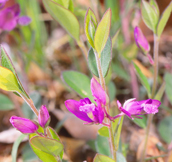
 Polygala japonica Polygalaceae
Polygala japonica Polygalaceae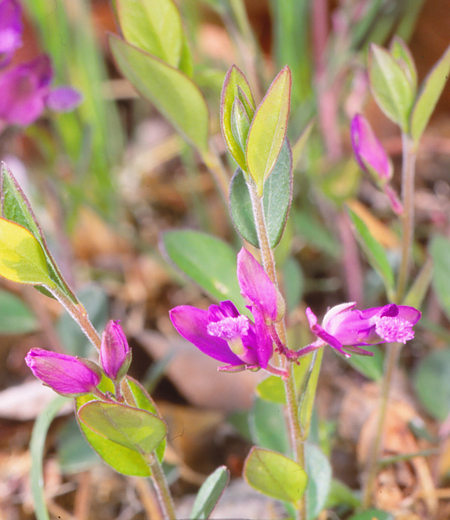 They are a perennial plant that grows at such arid places as at the sunny grasslands. (Perennial plant takes several years to grow). As the appearance of the flower looks like the one which is made as small as the flower of Lespedeza thunbergii (Fabaceae), this is how they are named ‘Polygala japonica’ (Himehagi). The flower is about 1 cm and tinged with red-purple color, a tubular shape flower composed of 3 flower petals, and the finely split bunch shoots to extend from the top.
They are a perennial plant that grows at such arid places as at the sunny grasslands. (Perennial plant takes several years to grow). As the appearance of the flower looks like the one which is made as small as the flower of Lespedeza thunbergii (Fabaceae), this is how they are named ‘Polygala japonica’ (Himehagi). The flower is about 1 cm and tinged with red-purple color, a tubular shape flower composed of 3 flower petals, and the finely split bunch shoots to extend from the top.
5 calyxes at the root portion of the flower is tinged with the same color with the flower petals, and 2 out of the five are open as if they are stretching the wings. When the flowers wither, he calyxes turn into green. The leaves are rounded egged-shaped with the sharp tip and trichome growing on both surfaces. The leaves during the flower season is about 1 centimeter long, they grow to be 3 cm long after the flower wither. Long white trichome develops on the stalk in cluster.
●Season Mid April to about Late May
●Height about 10 to 20 cm
●Place Mt.Inari, Ura-Takao, Minami-Takao -
Vicia angustifolia Leguminosae
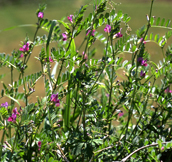
 Vicia angustifolia Leguminosae
Vicia angustifolia Leguminosae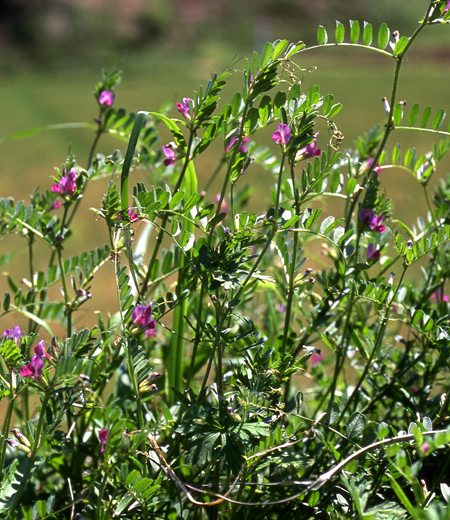 They are common biennial plant that grows at such sunny places as at the roadsides, rice fields, and a plain field (biennial plant sprouts in autumn, overwinter, and bear flowers in next spring). They bear Legume (Touka) about 3 to 5 cm long alike peas. The reason for their name is that the peas get matured to turn into black and people compare the black peas as scarecrows. Another name of theirs is ‘Vicia angustifolia var. segetalis’, and the name comes from that the leaves look like a nock (Yahazu: portion receiving a string, behind an arrow). The flower is about 1.5 cm in diameter, tinged with vivid red-purple color. 2 to 3 of the flowers sprout at the root of the leaves, and the flower petals seem to be the wings of butterfly. The leaf is a pinnate compound leaf consisting of 8 to 16 leaves in cluster (pinnate compound leaf: Ujohukuyo is the shape of the leaf that grows several small leaves at the leafstalk). 1 leaf is thin and long egged-shaped abut 2 to 3 cm long with the tip dent like Yahazu. We can enjoy eating this plant almost every portion such young leaves, young stems, flowers, young seeds as Tempura, fried food, and boiled food.
They are common biennial plant that grows at such sunny places as at the roadsides, rice fields, and a plain field (biennial plant sprouts in autumn, overwinter, and bear flowers in next spring). They bear Legume (Touka) about 3 to 5 cm long alike peas. The reason for their name is that the peas get matured to turn into black and people compare the black peas as scarecrows. Another name of theirs is ‘Vicia angustifolia var. segetalis’, and the name comes from that the leaves look like a nock (Yahazu: portion receiving a string, behind an arrow). The flower is about 1.5 cm in diameter, tinged with vivid red-purple color. 2 to 3 of the flowers sprout at the root of the leaves, and the flower petals seem to be the wings of butterfly. The leaf is a pinnate compound leaf consisting of 8 to 16 leaves in cluster (pinnate compound leaf: Ujohukuyo is the shape of the leaf that grows several small leaves at the leafstalk). 1 leaf is thin and long egged-shaped abut 2 to 3 cm long with the tip dent like Yahazu. We can enjoy eating this plant almost every portion such young leaves, young stems, flowers, young seeds as Tempura, fried food, and boiled food.
●Season March to about June
●Height about 50cm to 1m
●Place Ura-Takao, Oku-Takao -
Potentilla fragarioides var. major Rosaceae
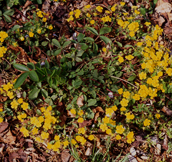
 Potentilla fragarioides var. major Rosaceae
Potentilla fragarioides var. major Rosaceae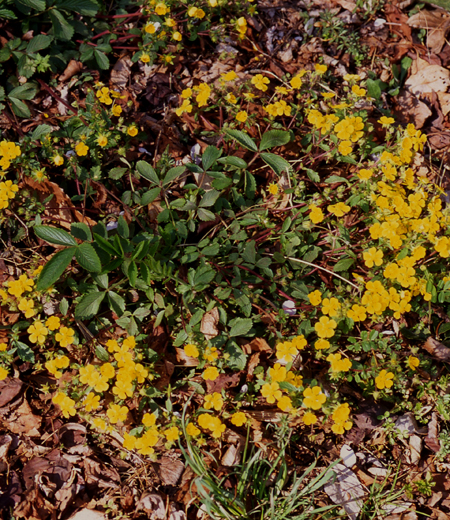 They are perennial plant that grows at sunny, bright forests or plain meadows (perennial plant takes several years to grow), and have coarse glandular trichome wholly. Their name comes from an episode that the stump of a tree spreading round on the ground looks like a woven mat (Mushiro: mat made of straw). They bear yellow flowers on the top of long, straight stalk. The flower is about 1.5 to 2 cm in diameter and its 5 flower petals open upward. The flower develops lateral shoot from the root, where several flowers bloom one after another. Radical leaf (KON-SEI-YOU: leaf sprouting around the root base) extending from the root consists of 5 to 9 lobules to become one leaf.
They are perennial plant that grows at sunny, bright forests or plain meadows (perennial plant takes several years to grow), and have coarse glandular trichome wholly. Their name comes from an episode that the stump of a tree spreading round on the ground looks like a woven mat (Mushiro: mat made of straw). They bear yellow flowers on the top of long, straight stalk. The flower is about 1.5 to 2 cm in diameter and its 5 flower petals open upward. The flower develops lateral shoot from the root, where several flowers bloom one after another. Radical leaf (KON-SEI-YOU: leaf sprouting around the root base) extending from the root consists of 5 to 9 lobules to become one leaf.
Among the leaves, three ones on the top are largest and about 3 cm long. Lobules (Shoyo: each one that is leaf-shaped and leaf like one consisting of more than a few leaves) is elliptical shape and has coarse sawtooth at the edge. After flowers wither, they grow to be about 50 cm high and bear the fruit with numerous small seeds on it.
●Season Mid April to about Mid May
●Height about 5 to 20 cm
●Place Mt.Inari, Ura-Takao, Oku-Takao -
Duchesnea chrysantha(False Strawberry) Rosaceae
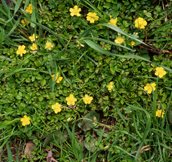
 Duchesnea chrysantha(False Strawberry) Rosaceae
Duchesnea chrysantha(False Strawberry) Rosaceae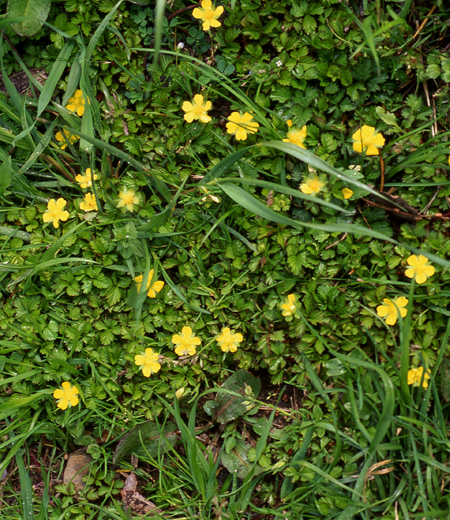 They are perennial plant that grows at a ridge between rice fields or humid meadow (perennial plant takes several years to grow). Stolon (Hohukukei: creeping stem on the ground) is the shooting stem on the ground, and each one expands roots from the knots to spread. Leaves are sent out successively even after withered so that they are evergreen plants all year round. Their name ‘Duchesnea chrysantha’ (Hebi-Ichigo) comes from the stories that snakes eat them, or they are strawberries that grow at where snakes gather. At times people call them Duchesnea chrysantha, but in fact they don’t bear any poisonous substances, have less sweet or moisture, what’ worse they don’t taste delicious to eat. Leaves are yellow-green with one set of 3 lobules (Shoyo: each one that is leaf-shaped and leaf like one consisting of more than a few leaves) on it. Lobules are elliptical shape some 2 to 3.5 cm long, and have thin sawtooth at the edge. Flower stalk (Kakei: stem of flower bearing only flowers without leaves) expands from the side of a leaf to have one yellow flower at its top. The flower is about 1.2 to 1.5 cm in diameter with five flower petals.
They are perennial plant that grows at a ridge between rice fields or humid meadow (perennial plant takes several years to grow). Stolon (Hohukukei: creeping stem on the ground) is the shooting stem on the ground, and each one expands roots from the knots to spread. Leaves are sent out successively even after withered so that they are evergreen plants all year round. Their name ‘Duchesnea chrysantha’ (Hebi-Ichigo) comes from the stories that snakes eat them, or they are strawberries that grow at where snakes gather. At times people call them Duchesnea chrysantha, but in fact they don’t bear any poisonous substances, have less sweet or moisture, what’ worse they don’t taste delicious to eat. Leaves are yellow-green with one set of 3 lobules (Shoyo: each one that is leaf-shaped and leaf like one consisting of more than a few leaves) on it. Lobules are elliptical shape some 2 to 3.5 cm long, and have thin sawtooth at the edge. Flower stalk (Kakei: stem of flower bearing only flowers without leaves) expands from the side of a leaf to have one yellow flower at its top. The flower is about 1.2 to 1.5 cm in diameter with five flower petals.
●Season March to about May
●Height about 5 cm
●Place Trail 1 to 3, Trail 5, Mt.Inari,Ura-Takao -
Mitella pauciflora Saxifragaceae
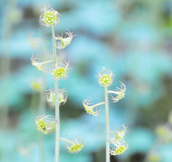
 Mitella pauciflora Saxifragaceae
Mitella pauciflora Saxifragaceae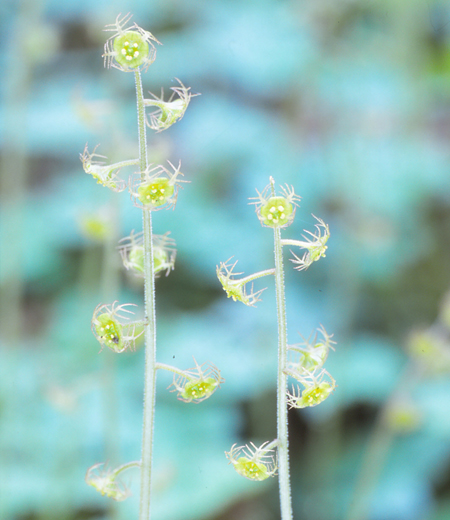 They are perennial plant that grows at humid places such as in the waterfront and rocky areas of mountain streams, in the depth of or within forest of mountain district, (perennial plant takes several years to grow). Mostly they grow in clusters in a location with stolon (runner: branch growing on the ground). As being most widespread Mitella furusei var. subramosa, the name comes from the episode that the shape of matured seed resembles Shawm-like instrument, a kind of horn. The flowers are about 1 cm in diameter, pale yellow-green or pale purplish crimson color, and some 10 of them bloom on the stalk here and there. One of their characteristics includes curious-shaped petals, which look like fish bone; stands out from pentagon shaped calyx. Another characteristic is radical leaf (KON-SEI-YO: leaf spring up from the place about stalk root), has a long stalk, is about 2 to 5 cm long, which is split shallow into 5 and the basic pat is heart-shaped, both of the surfaces have white long paraphyllium and spiny sawtooth at the edge. When matured, the seed bears tiny small seed.
They are perennial plant that grows at humid places such as in the waterfront and rocky areas of mountain streams, in the depth of or within forest of mountain district, (perennial plant takes several years to grow). Mostly they grow in clusters in a location with stolon (runner: branch growing on the ground). As being most widespread Mitella furusei var. subramosa, the name comes from the episode that the shape of matured seed resembles Shawm-like instrument, a kind of horn. The flowers are about 1 cm in diameter, pale yellow-green or pale purplish crimson color, and some 10 of them bloom on the stalk here and there. One of their characteristics includes curious-shaped petals, which look like fish bone; stands out from pentagon shaped calyx. Another characteristic is radical leaf (KON-SEI-YO: leaf spring up from the place about stalk root), has a long stalk, is about 2 to 5 cm long, which is split shallow into 5 and the basic pat is heart-shaped, both of the surfaces have white long paraphyllium and spiny sawtooth at the edge. When matured, the seed bears tiny small seed.
●Season Late March to about Early May
●Height about 10 to 20 cm
●Place Trail 1,Ura-Takao -
Chrysosplenium grayanum Saxifragaceae
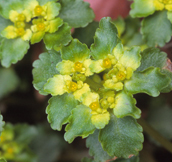
 Chrysosplenium grayanum Saxifragaceae
Chrysosplenium grayanum Saxifragaceae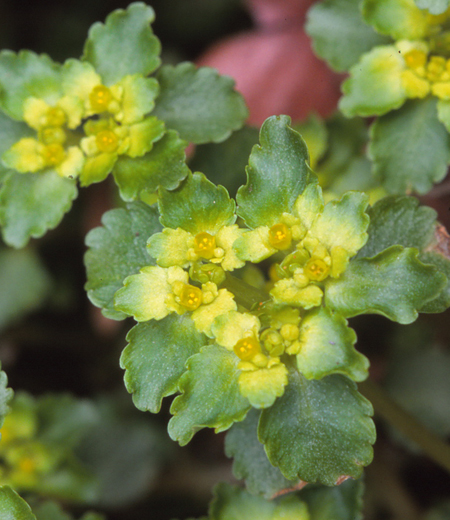 They are perennial plant that grows at humid places such as in the forest along mountain stream and at the deep pool of mountain rivers (perennial plant takes several years to grow). They spread stalks underground transversely, and grow in colonies to sprout roots from knots. After flows bloom, the seed gets matured and cracked. The shape of cracked seeds looks like cat’s eye. This is how they are named Chrysosplenium. About 10 flowers on the top of stalk gather to bloom. Their characteristics are that flowers are about 2 mm in diameters with no flower petals, the bract leaf surrounded with 4 calyxes and flower standing out in vivid yellow-green color and that is just like a flower itself (the bract leaf: transformed leaf at the root of flower stalk). The group of Chrysosplenium usually has 8 stamens, while the original group has only 4 in typical. This helps us which one to tell. The leaf is about 0.5 to 2 cm and grows from stalk like facing each other. The leaves are wide-egg shaped and have edge-round obtuse sawtooth at the edge.
They are perennial plant that grows at humid places such as in the forest along mountain stream and at the deep pool of mountain rivers (perennial plant takes several years to grow). They spread stalks underground transversely, and grow in colonies to sprout roots from knots. After flows bloom, the seed gets matured and cracked. The shape of cracked seeds looks like cat’s eye. This is how they are named Chrysosplenium. About 10 flowers on the top of stalk gather to bloom. Their characteristics are that flowers are about 2 mm in diameters with no flower petals, the bract leaf surrounded with 4 calyxes and flower standing out in vivid yellow-green color and that is just like a flower itself (the bract leaf: transformed leaf at the root of flower stalk). The group of Chrysosplenium usually has 8 stamens, while the original group has only 4 in typical. This helps us which one to tell. The leaf is about 0.5 to 2 cm and grows from stalk like facing each other. The leaves are wide-egg shaped and have edge-round obtuse sawtooth at the edge.
●Season April to about May
●Height about 5 to 20 cm
●Place Trail 1,Trail 4,Trail 6, Ura-Takao -
Chrysosplenium album var. stamineum Saxifragaceae
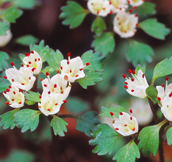
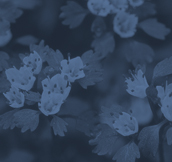 Chrysosplenium album var. stamineum Saxifragaceae
Chrysosplenium album var. stamineum Saxifragaceae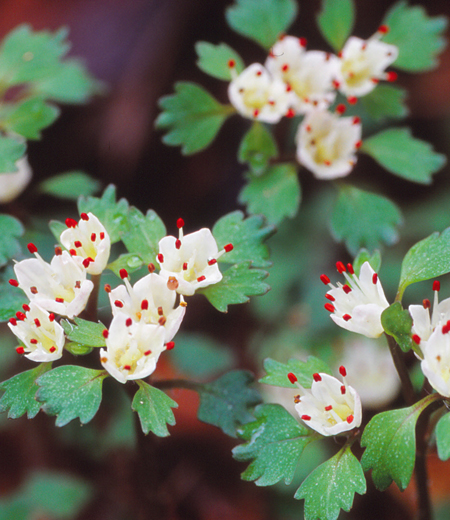 They are perennial plant that grows at humid pools of humid forest such as at rocky places along the mountain stream in mountain areas and (perennial plant takes several years to grow). Among the subdued flowers in the group of Chrysosplenium, their flowers are outstandingly beautiful, which is how they are named after. They bear a couple of small flowers about 5 mm in diameter at the top of straight stalk. With no actual flower petals, 4 white roundish calyxes are facing upward like flower petals, where 8 stamens with the top in red color come out from the inside, while white and red color contrast stands out remarkably. The leaves are roundish circular sector shape, about 5 to 8 mm long with dark green and edge-round obtuse sawtooth at the edge. After flowers wither, stalks begin to spread at the root to every direction. The stalk has sparse paraphyllium.
They are perennial plant that grows at humid pools of humid forest such as at rocky places along the mountain stream in mountain areas and (perennial plant takes several years to grow). Among the subdued flowers in the group of Chrysosplenium, their flowers are outstandingly beautiful, which is how they are named after. They bear a couple of small flowers about 5 mm in diameter at the top of straight stalk. With no actual flower petals, 4 white roundish calyxes are facing upward like flower petals, where 8 stamens with the top in red color come out from the inside, while white and red color contrast stands out remarkably. The leaves are roundish circular sector shape, about 5 to 8 mm long with dark green and edge-round obtuse sawtooth at the edge. After flowers wither, stalks begin to spread at the root to every direction. The stalk has sparse paraphyllium.
●Season Mid March to about Mid April
●Height about 5 to 10 cm
●Place Trail 1,Trail 6,Jyataki, Ura-Takao -
Chrysosplenium japonicum Saxifragaceae
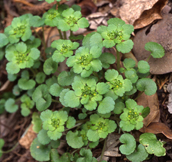
 Chrysosplenium japonicum Saxifragaceae
Chrysosplenium japonicum Saxifragaceae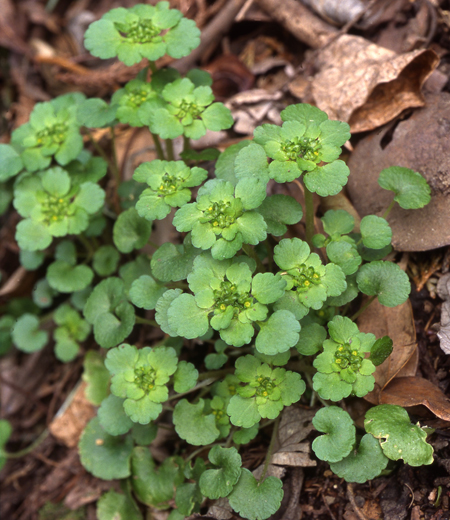 They are perennial plant that grows at humid forest such as at rocky places along the mountain stream in mountain areas and (perennial plant takes several years to grow) and begin to bloom earlier than Chrysosplenium grayanum. Flowers are about 5 mm in diameter. 4 calyxes in yellow-green resemble actual flower petals. The root of the calyxes yellowish, not flashy but beautiful. When blooming, calyxes are even flat; they stand upstraight after the flowers bloom. Entire atmosphere is very similar with Chrysosplenium grayanum, the difference between the two is that Chrysosplenium grayanum is alternate leaves, which mean the leaves grown alternate on the stalk. The leaf is about 1 to 3 cm long, kidney-shaped (the shaped of kidney), and heart-shaped with not sharp points. After the flowers bloom, propagule (Mukago: stored nourishment becomes spherical sprout) bear at the root with paraphyllium of flower stalk (Kakei: stalk that can have flowers without leaves).
They are perennial plant that grows at humid forest such as at rocky places along the mountain stream in mountain areas and (perennial plant takes several years to grow) and begin to bloom earlier than Chrysosplenium grayanum. Flowers are about 5 mm in diameter. 4 calyxes in yellow-green resemble actual flower petals. The root of the calyxes yellowish, not flashy but beautiful. When blooming, calyxes are even flat; they stand upstraight after the flowers bloom. Entire atmosphere is very similar with Chrysosplenium grayanum, the difference between the two is that Chrysosplenium grayanum is alternate leaves, which mean the leaves grown alternate on the stalk. The leaf is about 1 to 3 cm long, kidney-shaped (the shaped of kidney), and heart-shaped with not sharp points. After the flowers bloom, propagule (Mukago: stored nourishment becomes spherical sprout) bear at the root with paraphyllium of flower stalk (Kakei: stalk that can have flowers without leaves).
●Season March to about April
●Height about 10 to 20 cm
●Place Trail 3,Trail 6,Jyataki,Ura-Takao -
Saxifraga stolonifera Saxifragaceae
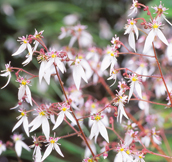
 Saxifraga stolonifera Saxifragaceae
Saxifraga stolonifera Saxifragaceae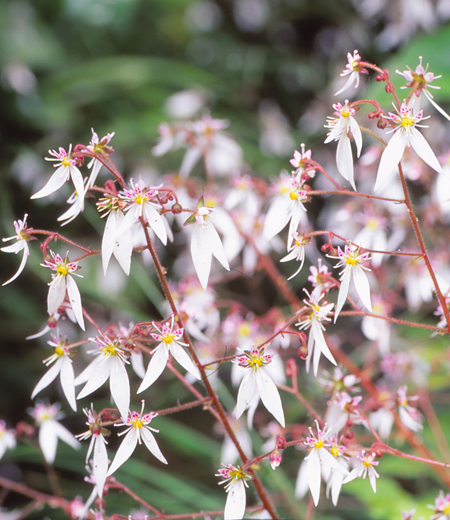 They are perennial plant that grows at humid places on rocks (perennial plant takes several years to grow). It is said the reason for their name is that their leaves remain green, not withered even under the snow in the midst of winter. Flowers have white 5 peals, of which 2 petals at down portion are about 1 to 2 cm long and dangling.
They are perennial plant that grows at humid places on rocks (perennial plant takes several years to grow). It is said the reason for their name is that their leaves remain green, not withered even under the snow in the midst of winter. Flowers have white 5 peals, of which 2 petals at down portion are about 1 to 2 cm long and dangling.
The rest of 3 are small and have dark red speckles. Flower stalk (Kakei: stem of flower bearing only flowers without leaves) has thin glandular trichome on it, where many flowers bloom into a cone form like decorations of Christmas tree. Leaves are 3 to 6 cm long, roundish kidney-shaped, and have a long stalk growing from the root. The surface of the leaf is dark green and has white patterns along the veins of leaves. The back surface is tinged with dark violet with lots of brown glandular trichome. Their characteristic of a leaf is thick and soft as well as folk remedy used effective for burn injury and eaten as edible wild plants.
●Season Late May to about Late June
●Height about 20 to 50 cm
●Place Trail 1,Trail 6, Jyataki,Oku-Takao -
Chrysosplenium macrostemon var. atrandrum Saxifragaceae
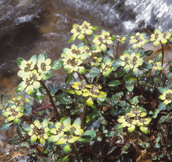
 Chrysosplenium macrostemon var. atrandrum Saxifragaceae
Chrysosplenium macrostemon var. atrandrum Saxifragaceae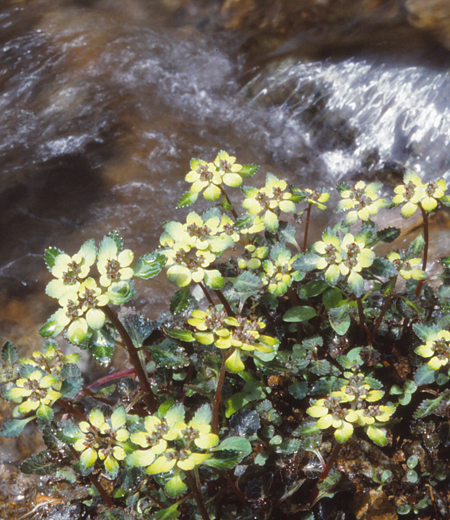 They are perennial plant that grows at humid forest such as at rocky places along the mountain stream in mountain areas and (perennial plant takes several years to grow). The dark green leaves have grayish patterns. These patterns are like being covered with dust, and that is why they are named Chrysosplenium macrostemon var. atrandrum. The flowers are 3 to 4 mm in diameter and its characteristic is that 4 dark red flower-like calyxes rise perpendicularly. Inside of calyxes are stamens, and just below the yellow bract leaf spread (Houyou: a modified leaf or leaflike part just below flower stalk).
They are perennial plant that grows at humid forest such as at rocky places along the mountain stream in mountain areas and (perennial plant takes several years to grow). The dark green leaves have grayish patterns. These patterns are like being covered with dust, and that is why they are named Chrysosplenium macrostemon var. atrandrum. The flowers are 3 to 4 mm in diameter and its characteristic is that 4 dark red flower-like calyxes rise perpendicularly. Inside of calyxes are stamens, and just below the yellow bract leaf spread (Houyou: a modified leaf or leaflike part just below flower stalk).
The number of stamen is four, the same with the one of Chrysosplenium grayanum. When the flowers wither, the flower stalk spread to four directions resulting in growing large several leaves. Though they are a mutation of Chrysosplenium macrostemon (as known as by Chrysosplenium macrostemon) and both grow at similar circumstances, the point to distinguish is Chrysosplenium macrostemon has yellow-green calyx and their stamen is yellow.
●Season Late March to about Mid April
●Height about 5 to 15 cm
●Place Trail 1,5 to6, Mt.Inari, Jyataki, Ura-Takao,Oku-Takao -
Cardamine appendiculata Cruciferae
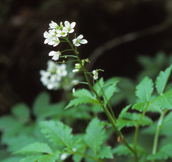
 Cardamine appendiculata Cruciferae
Cardamine appendiculata Cruciferae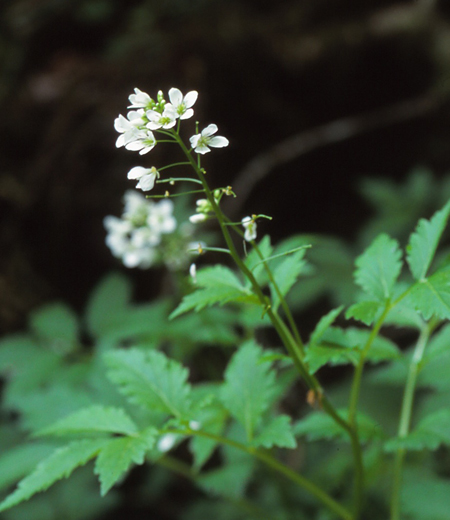 Biennial herbs (Sprout in autumn and spent winter and bloom on the following season) found in wet areas in mountains. In Mt. Takao, found in streamside. Are tall for wild plants and easy to find as they grow in clumps. Flowers are white, cross-shaped and 1 cm in diameter but looks white because they bloom in clusters. Leaves are pinnately compound leaves, the leaflets arranged opposite on a leaf stem like wings of birds. The shape of leaves is oval-shaped like eyes with toothed margins (edges of leaves are like a teeth of saw). Have protrusions like ears covering stems at the petioles that are to identify this plant from similar plants of cardamine leucantha with white flowers. Another name in Japanese Datenoumi-konronso was named because it was first found at Datenoumi in Nikko-yumoto, Tochigi prefecture (konronso means cardamine leucantha).
Biennial herbs (Sprout in autumn and spent winter and bloom on the following season) found in wet areas in mountains. In Mt. Takao, found in streamside. Are tall for wild plants and easy to find as they grow in clumps. Flowers are white, cross-shaped and 1 cm in diameter but looks white because they bloom in clusters. Leaves are pinnately compound leaves, the leaflets arranged opposite on a leaf stem like wings of birds. The shape of leaves is oval-shaped like eyes with toothed margins (edges of leaves are like a teeth of saw). Have protrusions like ears covering stems at the petioles that are to identify this plant from similar plants of cardamine leucantha with white flowers. Another name in Japanese Datenoumi-konronso was named because it was first found at Datenoumi in Nikko-yumoto, Tochigi prefecture (konronso means cardamine leucantha).
●Season Mid April to Late May
●Height about 30 to 50 cm
●Place Ura-Takao, Minami-Takao -
Cardamine tanakae Cruciferae
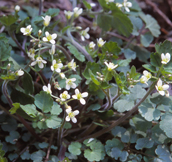
 Cardamine tanakae Cruciferae
Cardamine tanakae Cruciferae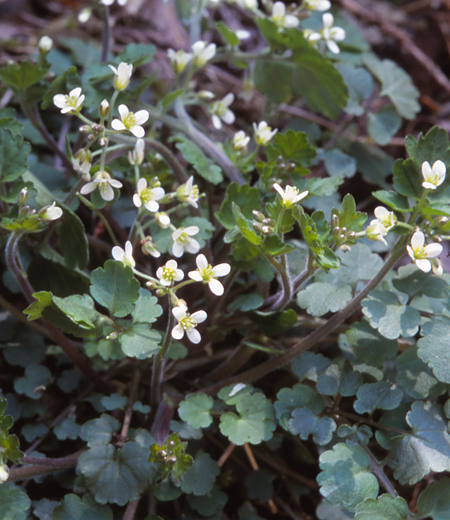 Biennial herbs (Sprout in autumn and spent winter and bloom on the following season) found in wet and shady areas in mountains. Unlike cardamine appendiculata grow near streams, this plant grow in forests. The Japanese name Maruba-konronso literally meaning round shaped leaves was named because shape of leaves are round-shaped compare to other plants. Have white soft hair on entire plants and this is where to identify this plant from other plants in cardamine leucantha genes. Leaves are pinnately compound leaves (small leaflets arranged on a leaf stalk) and five to seven leaves placed as a set. Have round-edged toothed margins (edges of leaves are like a teeth of saw). Flowers are white, cross-shaped four petals, 6 mm in diameter and some flowers bloom on the tip of stem. A part of the Japanese name, konron was named after the snow in Mt. Konron in China for the white flowers of this plant.
Biennial herbs (Sprout in autumn and spent winter and bloom on the following season) found in wet and shady areas in mountains. Unlike cardamine appendiculata grow near streams, this plant grow in forests. The Japanese name Maruba-konronso literally meaning round shaped leaves was named because shape of leaves are round-shaped compare to other plants. Have white soft hair on entire plants and this is where to identify this plant from other plants in cardamine leucantha genes. Leaves are pinnately compound leaves (small leaflets arranged on a leaf stalk) and five to seven leaves placed as a set. Have round-edged toothed margins (edges of leaves are like a teeth of saw). Flowers are white, cross-shaped four petals, 6 mm in diameter and some flowers bloom on the tip of stem. A part of the Japanese name, konron was named after the snow in Mt. Konron in China for the white flowers of this plant.
●Season Early April to Mid May
●Height about 10 to 20 cm
●Place Ura-Takao -
Wasabia tenuis Cruciferae
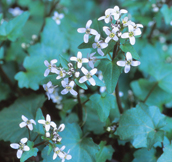
 Wasabia tenuis Cruciferae
Wasabia tenuis Cruciferae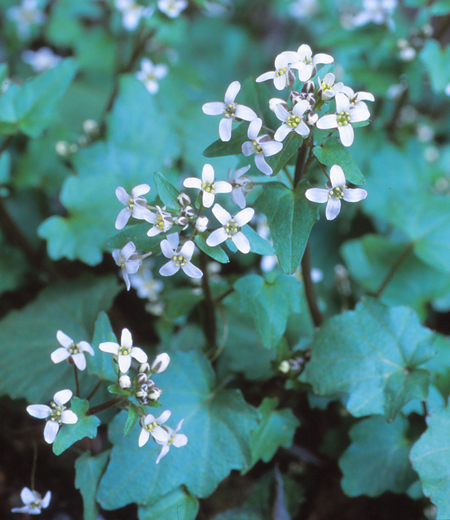 Perennial herbs (grow for several years from their same root system) found in wet areas near streams with many pebbles. Is an earliest blooming flower in early spring. After leaves wither, the base of stem swell and remain which resembles the bulbs of lilies (lily bulb, but it is actually fleshy leaf with nutrients), hence the Japanese name Yuri-wasabi literally meaning lily wasabi. The entire plants are a smaller sized wasabi (Japanese horseradish). Whereas wasabi stems grow upright, this plant stems grow along the ground. Bloom many white cross-shaped flowers and1 cm in diameter. Leaves are heart-shaped with toothed margins (edges of leaves are like a teeth of saw). Leaves grow near a root is larger and become smaller as it goes up. Leaves and rhizomes have a spicy taste like wasabi.
Perennial herbs (grow for several years from their same root system) found in wet areas near streams with many pebbles. Is an earliest blooming flower in early spring. After leaves wither, the base of stem swell and remain which resembles the bulbs of lilies (lily bulb, but it is actually fleshy leaf with nutrients), hence the Japanese name Yuri-wasabi literally meaning lily wasabi. The entire plants are a smaller sized wasabi (Japanese horseradish). Whereas wasabi stems grow upright, this plant stems grow along the ground. Bloom many white cross-shaped flowers and1 cm in diameter. Leaves are heart-shaped with toothed margins (edges of leaves are like a teeth of saw). Leaves grow near a root is larger and become smaller as it goes up. Leaves and rhizomes have a spicy taste like wasabi.
●Season Mid March to Late April
●Height about 10 to 30cm
●Place Trail 1 to 6, Mt. Inari, Jyataki, Ura-Takao, Minami-Takao, Kita-Takao -
Chelidonium majus Papaveraceae
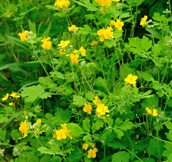
 Chelidonium majus Papaveraceae
Chelidonium majus Papaveraceae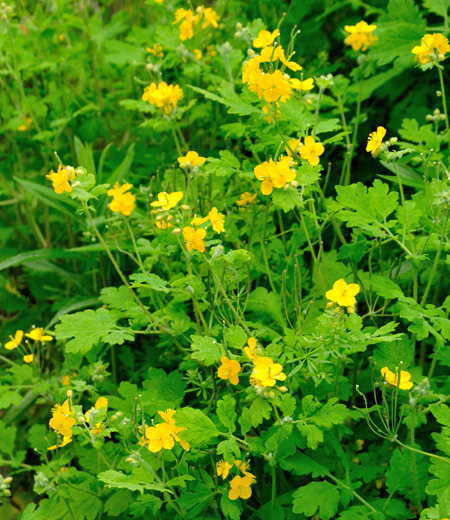 Biennial herbs (Sprout in autumn and spent winter and bloom on the following season) found in sunny roadside and grasslands in mountains. Have deep yellow juice when bending stems, hence the Japanese name Kurano-ou literally meaning grass yellow. However, there is another theory that this plant is used to cure skin disease literally translated as the king of blotches. Leaves and stems have curly white hair and look white when looking at this plant in a distance. Flowers are 2 to 3 cm in diameter and bloom several yellow flowers at the tips of long stems. Radical leaves (leaves grow from roots) are like rootstock and texture is soft. Leaves on stems are like feathery shaped. Most plants in papaveraceae family are poisonous including alkaroid. This plant is also poisonous and cause vomiting or stomach pain when eaten by mistake.
Biennial herbs (Sprout in autumn and spent winter and bloom on the following season) found in sunny roadside and grasslands in mountains. Have deep yellow juice when bending stems, hence the Japanese name Kurano-ou literally meaning grass yellow. However, there is another theory that this plant is used to cure skin disease literally translated as the king of blotches. Leaves and stems have curly white hair and look white when looking at this plant in a distance. Flowers are 2 to 3 cm in diameter and bloom several yellow flowers at the tips of long stems. Radical leaves (leaves grow from roots) are like rootstock and texture is soft. Leaves on stems are like feathery shaped. Most plants in papaveraceae family are poisonous including alkaroid. This plant is also poisonous and cause vomiting or stomach pain when eaten by mistake.
●Season May to July
●Height about 30 to 80 cm
●Place Trail 1, Trail 4 to 6, Mt. Inari, Ura-Takao, Kita-Takao -
Corydalis decumbens Papaveraceae
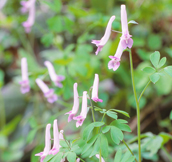
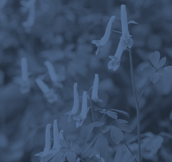 Corydalis decumbens Papaveraceae
Corydalis decumbens Papaveraceae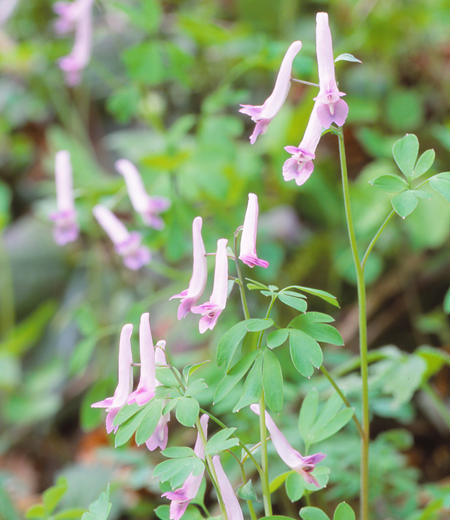 Perennial herbs found in bright forests and at forest edges in mountains and open fields. Similar to corydalis lineariloba, but this plant is easily identified with slightly thin flowers and untoothed bracts. The Japanese name Jirobo-engosaku was named because viola is called “Taro-bo” (the first son in the family) in Ise region, and this plants was named “Jiro-bo” (the second son in the family). This is because people used to call this flower with endearing feeling as children played by crossing elongated parts from corolla including spur and pulling to see which is strong. Flowers are tubular and 1..5 cm long. The color of flowers is red-purple to blue-purple and white in rare cases. Have several thin stems grow upright from a thick underground stem. Leaves on stems have patterns and in whorls of three and egg-shaped.
Perennial herbs found in bright forests and at forest edges in mountains and open fields. Similar to corydalis lineariloba, but this plant is easily identified with slightly thin flowers and untoothed bracts. The Japanese name Jirobo-engosaku was named because viola is called “Taro-bo” (the first son in the family) in Ise region, and this plants was named “Jiro-bo” (the second son in the family). This is because people used to call this flower with endearing feeling as children played by crossing elongated parts from corolla including spur and pulling to see which is strong. Flowers are tubular and 1..5 cm long. The color of flowers is red-purple to blue-purple and white in rare cases. Have several thin stems grow upright from a thick underground stem. Leaves on stems have patterns and in whorls of three and egg-shaped.
●Season Early April to about Late April
●Height about 10 to 20 cm
●Place Ura-Takao, Kita-Takao -
Corydalis pallida var. tenuis Papaveraceae
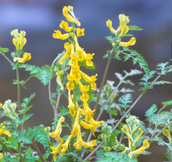
 Corydalis pallida var. tenuis Papaveraceae
Corydalis pallida var. tenuis Papaveraceae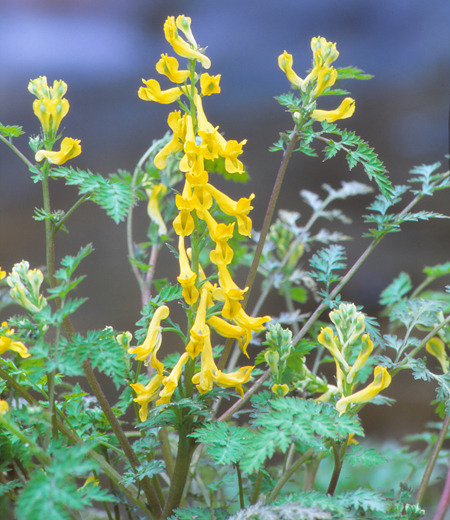 Biennial herbs found on sunny roadside, at forest edge and in deforested areas. The Japanese name is Miyama-ki-keman literally meaning deep in the mountain yellow flower wreath but this plant is also found in low elevations. Have many flowers on the tip of single stem that is appealing. This is the yellow version of corydalis incisa and also poisonous. In April, grow upright stem from the center of the plant and bloom many tubular flowers with two lips and about 2 cm long. Leaves vary from white powdered-like green to reddish green ones. Is soft texture with toothed margins and have unique rubber-like smell when it is rubbed. After flowering, bear 3 cm long beads-like fruits.
Biennial herbs found on sunny roadside, at forest edge and in deforested areas. The Japanese name is Miyama-ki-keman literally meaning deep in the mountain yellow flower wreath but this plant is also found in low elevations. Have many flowers on the tip of single stem that is appealing. This is the yellow version of corydalis incisa and also poisonous. In April, grow upright stem from the center of the plant and bloom many tubular flowers with two lips and about 2 cm long. Leaves vary from white powdered-like green to reddish green ones. Is soft texture with toothed margins and have unique rubber-like smell when it is rubbed. After flowering, bear 3 cm long beads-like fruits.
●Season Early April to about Mid May
●Height about 20 to 40 cm
●Place Trail 1 to 3, Trail 5, Jyataki, Ura-Takao, Oku-Takao -
Corydalis incisa Papaveraceae

 Corydalis incisa Papaveraceae
Corydalis incisa Papaveraceae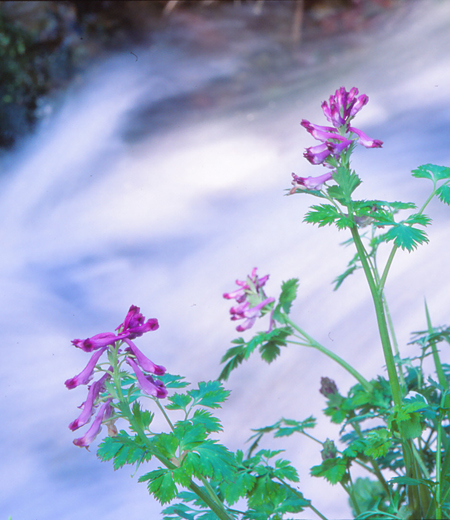 Biennial herbs found on bright forest floor and at forest edges in mountains and also in flatlands. The Japanese name is Murasaki-keman was named after the flower resembles keman which is the flower wreath decorated on Buddhist alter. The entire plant is soft but emit bad odor when scratched. Radical leaves grow covering ground and spent winter. In spring, stem grows upright and bloom many flowers about 1..5 cm long. Color of flowers is red-purple and similar to corydalis lineariloba and corydalis decumbens but this plant has finely toothed leaves like the leaves of carrots. The entire plants are poisonous and cause vomiting when eaten by mistake. In Mt. Takao, caterpillars of Japanese clouded apollo feed on leaves of this plant.
Biennial herbs found on bright forest floor and at forest edges in mountains and also in flatlands. The Japanese name is Murasaki-keman was named after the flower resembles keman which is the flower wreath decorated on Buddhist alter. The entire plant is soft but emit bad odor when scratched. Radical leaves grow covering ground and spent winter. In spring, stem grows upright and bloom many flowers about 1..5 cm long. Color of flowers is red-purple and similar to corydalis lineariloba and corydalis decumbens but this plant has finely toothed leaves like the leaves of carrots. The entire plants are poisonous and cause vomiting when eaten by mistake. In Mt. Takao, caterpillars of Japanese clouded apollo feed on leaves of this plant.
●Season Early April to about Mid May
●Height about20 to 50 cm
●Place Trail 1, Trail 3, Mt. Inari, Ura-Takao, Oku-Takao, Minami-Takao -
Corydalis lineariloba Papaveraceae
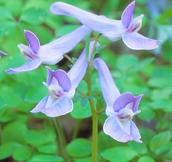
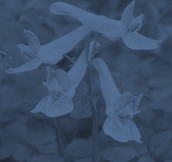 Corydalis lineariloba Papaveraceae
Corydalis lineariloba Papaveraceae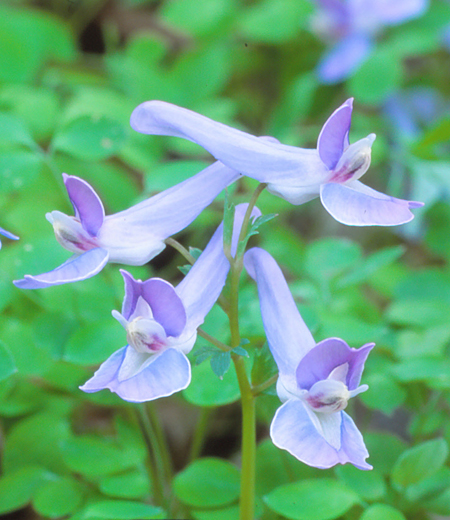 Perennial herbs (grow for several years from their same root system) found at bright forest edges and in forests in mountains fields. In Mt. Takao, found in wet areas including streamside. Bloom pointed hat-like shaped flowers in early spring. Flowers are 2 cm long, red-purple to blue-purple. Become more bluish at higher elevations or northern area. Bracts (variants of leaves at the base of petals) are lobed but similar corydalis decumbens are not. This is where to identify this plant. Leaves are ternate compound leaves, three leaves as one set grow from long petioles. The shape of leaves are like foot of birds and pinnate in three. Small underground stems are used as herbal medicine called Engosaku to ease pain or cramps.
Perennial herbs (grow for several years from their same root system) found at bright forest edges and in forests in mountains fields. In Mt. Takao, found in wet areas including streamside. Bloom pointed hat-like shaped flowers in early spring. Flowers are 2 cm long, red-purple to blue-purple. Become more bluish at higher elevations or northern area. Bracts (variants of leaves at the base of petals) are lobed but similar corydalis decumbens are not. This is where to identify this plant. Leaves are ternate compound leaves, three leaves as one set grow from long petioles. The shape of leaves are like foot of birds and pinnate in three. Small underground stems are used as herbal medicine called Engosaku to ease pain or cramps.
●Season Late March to Mid April
●Height about 10 to 20 cm
●Place Ura-Takao, Kita-Takao -
Chelidonicum japonica Papaveraceae
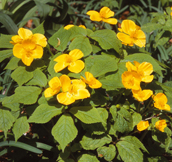
 Chelidonicum japonica Papaveraceae
Chelidonicum japonica Papaveraceae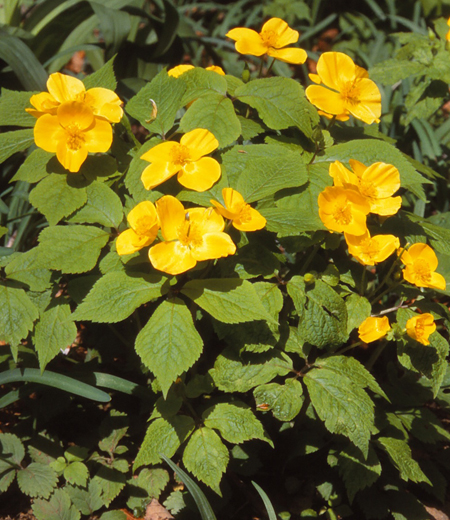 Perennial herbs found on swampy forest ground. Normally found in clumps and is very appealing with them in bloom. The Japanese name Yamabuki-so was named after the shape of flower resembling yamabuki, Japanese kerria. This is also called as kusa-yamabuki literally meaning grass Japanese kerria. Flowers are about 5 cm in diameter with four petals but Japanese kerria have five petals. Texture is soft and the yellow sap ooze when stems are scratched. Five to seven small radical leaves grow from the base of the plant. The shape of leaves is egg-shaped to oval-shaped with toothed margins. Leaves on stems are in whirls of three. After flowering, bear 3 cm long elongated fruits and plants on the ground die off.
Perennial herbs found on swampy forest ground. Normally found in clumps and is very appealing with them in bloom. The Japanese name Yamabuki-so was named after the shape of flower resembling yamabuki, Japanese kerria. This is also called as kusa-yamabuki literally meaning grass Japanese kerria. Flowers are about 5 cm in diameter with four petals but Japanese kerria have five petals. Texture is soft and the yellow sap ooze when stems are scratched. Five to seven small radical leaves grow from the base of the plant. The shape of leaves is egg-shaped to oval-shaped with toothed margins. Leaves on stems are in whirls of three. After flowering, bear 3 cm long elongated fruits and plants on the ground die off.
●Season Late April to about Mid May
●Height about 30 to 40 cm
●Place Minami-Takao -
Epimedium grandiflorum var. thunbergianum(Barrenwort) Berberidaceae
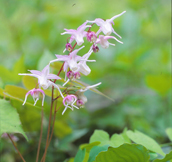
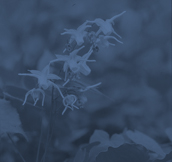 Epimedium grandiflorum var. thunbergianum(Barrenwort) Berberidaceae
Epimedium grandiflorum var. thunbergianum(Barrenwort) Berberidaceae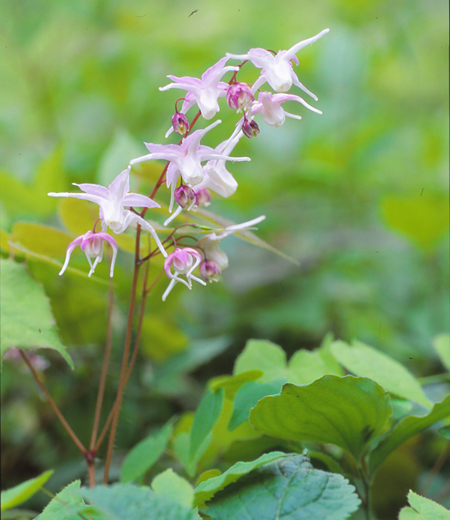 They are perennial plant that grows in the depth of or within forest of mountain district (perennial plant takes several years to grow). The Japanese name ‘Ikai-sou’ is named after the flower shape that looks like an anchor of ships. The flower is pale purplish crimson 2 cm in diameter and 4 flower petals bloom that have long spur - tubular extension at the base of the corolla at the tip of stem. Spur is 1.5 to 2 cm long and stores honey. Leaves are 3 to 8 cm long and crooked egg-shaped with spiny sawtooth at the edge. Their leafstalk consists of three separate portions, which grow to have leaves each. This is why they are also called ‘Epimedium grandiflorum’. Their underground stem spread its roots, where roots like the mustache sprout. From way back people have utilized the root as a medicine of tonic. After the flowers wither, they bear seeds like pod peas or beans. The seed has white strophiole or caruncle as a fatty mass that ants love so much to bring the seed to somewhere.
They are perennial plant that grows in the depth of or within forest of mountain district (perennial plant takes several years to grow). The Japanese name ‘Ikai-sou’ is named after the flower shape that looks like an anchor of ships. The flower is pale purplish crimson 2 cm in diameter and 4 flower petals bloom that have long spur - tubular extension at the base of the corolla at the tip of stem. Spur is 1.5 to 2 cm long and stores honey. Leaves are 3 to 8 cm long and crooked egg-shaped with spiny sawtooth at the edge. Their leafstalk consists of three separate portions, which grow to have leaves each. This is why they are also called ‘Epimedium grandiflorum’. Their underground stem spread its roots, where roots like the mustache sprout. From way back people have utilized the root as a medicine of tonic. After the flowers wither, they bear seeds like pod peas or beans. The seed has white strophiole or caruncle as a fatty mass that ants love so much to bring the seed to somewhere.
●Season about Mid April to Mid May
●Height about 20 to 40 cm
●Place Ura-Takao -
Anemone raddeana Ranunculaceae
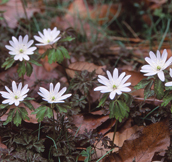
 Anemone raddeana Ranunculaceae
Anemone raddeana Ranunculaceae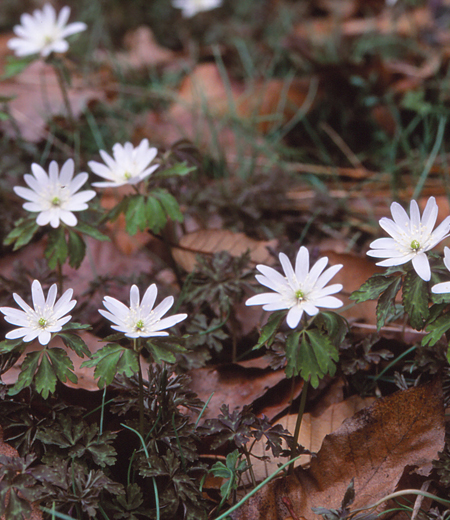 Perennial herbs (grow for several years from their same root system) found in bright forests and grasslands in mountains in early spring. One of the plants indicates the coming of spring and often found at forest edges of deciduous forests along streams. Flowers are 3 to 4 cm in diameter. One white flower blooms at the tip of a stem. The Japanese name Azuma-ichi-ge literally meaning one flower in east area was named because many of them grow in Kanto region and bloom only one flower. Leaves are trifoliate compound leaves and have three small flowers as one set. The size of leaves is 2 to 3 cm long with round edges, soft texture and dropping. Similar to anemone pseudo-altaica but the leaves of this plant have toothed margins.
Perennial herbs (grow for several years from their same root system) found in bright forests and grasslands in mountains in early spring. One of the plants indicates the coming of spring and often found at forest edges of deciduous forests along streams. Flowers are 3 to 4 cm in diameter. One white flower blooms at the tip of a stem. The Japanese name Azuma-ichi-ge literally meaning one flower in east area was named because many of them grow in Kanto region and bloom only one flower. Leaves are trifoliate compound leaves and have three small flowers as one set. The size of leaves is 2 to 3 cm long with round edges, soft texture and dropping. Similar to anemone pseudo-altaica but the leaves of this plant have toothed margins.
●Season Late March to Late April
●Height about 10 to 15 cm
●Place Ura-Takao, Minami-Takao -
Anemone nikoensis Ranunculaceae
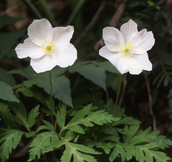
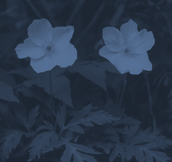 Anemone nikoensis Ranunculaceae
Anemone nikoensis Ranunculaceae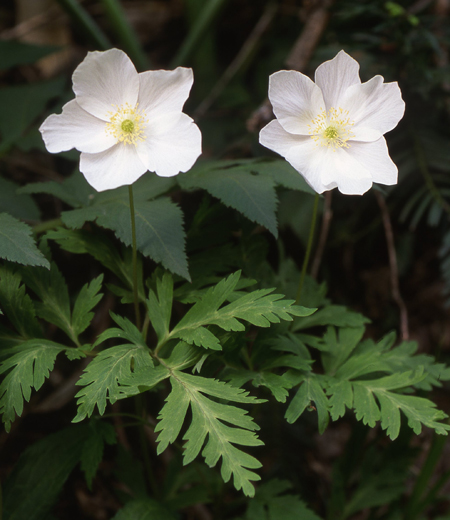 Perennial herbs (grow for several years from their same root system) found in wet areas including bright forest edges, grasslands along streamside in mountains. The Japanese name Ichirin-so literally meaning one flower on a stem was named because it only blooms one large flower on the top of a stem. In rare cases, bloom two flowers that may look like anemone flaccid. The point to identify this plant is leaves are finely lobed and flowers are large. Flowers are 4 cm in diameter and very appealing with five to six sepals like petals. Most of them are white but some are light purple on the back, hence another name Ura-beni-ichige literally meaning one flower with red on the back. Three leaves on long petioles grow from the middle of stems. Leaves are deeply lobed like serrated edge.
Perennial herbs (grow for several years from their same root system) found in wet areas including bright forest edges, grasslands along streamside in mountains. The Japanese name Ichirin-so literally meaning one flower on a stem was named because it only blooms one large flower on the top of a stem. In rare cases, bloom two flowers that may look like anemone flaccid. The point to identify this plant is leaves are finely lobed and flowers are large. Flowers are 4 cm in diameter and very appealing with five to six sepals like petals. Most of them are white but some are light purple on the back, hence another name Ura-beni-ichige literally meaning one flower with red on the back. Three leaves on long petioles grow from the middle of stems. Leaves are deeply lobed like serrated edge.
●Season Mid April to Mid May
●Height about 15 to 20 cm
●Place Ura-Takao, Minami-Takao -
Ranunculus japonicas(Japanese Buttercup) Ranunculaceae
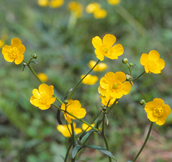
 Ranunculus japonicas(Japanese Buttercup) Ranunculaceae
Ranunculus japonicas(Japanese Buttercup) Ranunculaceae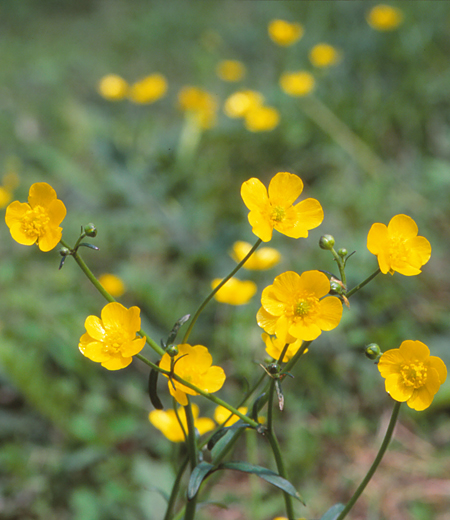 Perennial herbs (grow for several years from their same root system) found in sunny roadside in mountains. The Japanese name Umano-ashidaka literally meaning footprint of horses, because radical leaves are like footprint of horses, however it actually does not look like it at all. Radical leaves grow on long petioles with palmate three to five leaves. Lately, it is often called as Kinpouge. Flowers are 2 cm in diameter and bloom shiny yellow flowers with five petals facing upward. Stems and leaf stems have hair grow vertically. Is poisonous and cause addiction when eaten by mistake. Skin may swell when touching juice.
Perennial herbs (grow for several years from their same root system) found in sunny roadside in mountains. The Japanese name Umano-ashidaka literally meaning footprint of horses, because radical leaves are like footprint of horses, however it actually does not look like it at all. Radical leaves grow on long petioles with palmate three to five leaves. Lately, it is often called as Kinpouge. Flowers are 2 cm in diameter and bloom shiny yellow flowers with five petals facing upward. Stems and leaf stems have hair grow vertically. Is poisonous and cause addiction when eaten by mistake. Skin may swell when touching juice.
●Season April to May
●Height about 30 to 60 cm
●Place Trail 5, Mt. Inari, Oku-Takao -
Anemone pseudo-altaica Ranunculaceae
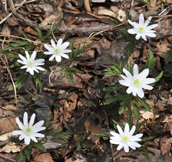
 Anemone pseudo-altaica Ranunculaceae
Anemone pseudo-altaica Ranunculaceae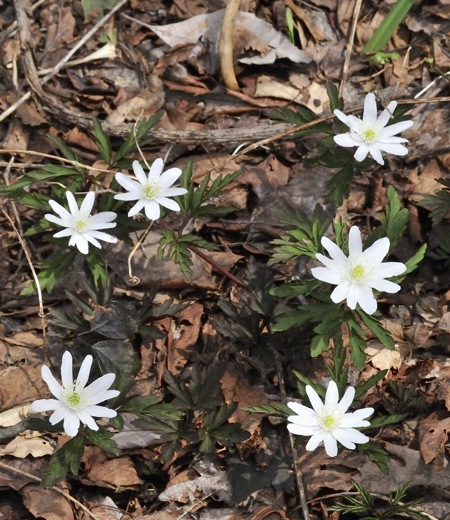 Perennial herbs (grow for several years from their same root system) found in wet areas in forests or streamside. In Mt. Takao, numbers are limited and bloom after anemone raddeana. The Japanese name Kikuza-ichige literally meaning bloom chrysanthemum one flower was named because flowers resemble chrysanthemum. Flowers are about 3 cm in diameter and bloom only one. Another name is Kikuza-ichirinso also means chrysanthemum one flower. Have short hair on peduncles. The petal-like parts are sepals and the color is white to dark purple but ones bloom around Tokyo area is mostly white. When sun is not out, flowers do not open. It is a very delicate plants and wither if trees grow and cover this plant. Leaves are trifoliate compound leaves and deeply pinnate with toothed margins and open horizontally under flowers.
Perennial herbs (grow for several years from their same root system) found in wet areas in forests or streamside. In Mt. Takao, numbers are limited and bloom after anemone raddeana. The Japanese name Kikuza-ichige literally meaning bloom chrysanthemum one flower was named because flowers resemble chrysanthemum. Flowers are about 3 cm in diameter and bloom only one. Another name is Kikuza-ichirinso also means chrysanthemum one flower. Have short hair on peduncles. The petal-like parts are sepals and the color is white to dark purple but ones bloom around Tokyo area is mostly white. When sun is not out, flowers do not open. It is a very delicate plants and wither if trees grow and cover this plant. Leaves are trifoliate compound leaves and deeply pinnate with toothed margins and open horizontally under flowers.
●Season Late March to Mid April
●Height about 10 to 15 cm
●Place Ura-Takao -
Dichocarpum trachyspermum Ranunculaceae
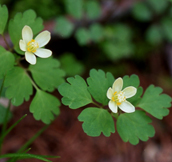
 Dichocarpum trachyspermum Ranunculaceae
Dichocarpum trachyspermum Ranunculaceae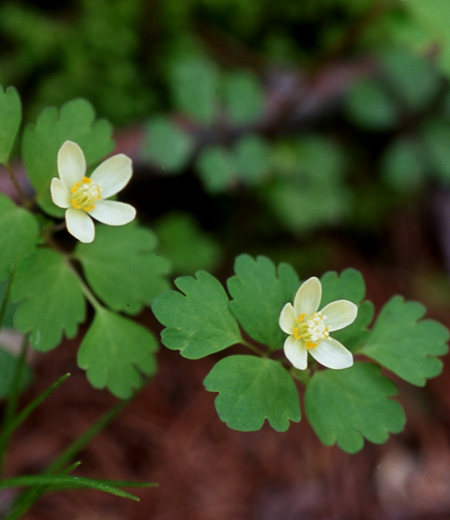 Perennial herbs (grow for several years from their same root system) found in wet areas including streamside, roadside and forest edges in mountains. Have a soft impression without hair. After flowering, bloom two opposite elongated green fruits. This look like the tails of mackerel and many grow in Kanto region, hence the Japanese name Tougoku-sabanoo literally meaning tail of mackerel in the east. Flowers are 6 to 8 mm in diameters and light cream color. Have yellow petals like sumo referee’s fan inside of sepals looks like flower petals. Leaves are light green and radical leaves (leaves grow from the roots) near the root. Stems have three to five leaves alternate. The shape of leaves is like fans with toothed margins (edges of leaves are like a teeth of saw). Bloom cleistogamous flowers (never open and self-pollinating) at the base of a stem in summer.
Perennial herbs (grow for several years from their same root system) found in wet areas including streamside, roadside and forest edges in mountains. Have a soft impression without hair. After flowering, bloom two opposite elongated green fruits. This look like the tails of mackerel and many grow in Kanto region, hence the Japanese name Tougoku-sabanoo literally meaning tail of mackerel in the east. Flowers are 6 to 8 mm in diameters and light cream color. Have yellow petals like sumo referee’s fan inside of sepals looks like flower petals. Leaves are light green and radical leaves (leaves grow from the roots) near the root. Stems have three to five leaves alternate. The shape of leaves is like fans with toothed margins (edges of leaves are like a teeth of saw). Bloom cleistogamous flowers (never open and self-pollinating) at the base of a stem in summer.
●Season Early April to Early May
●Height about 10 to 15 cm
●Place Ura-Takao, Minami-Takao -
Anemone flaccida Ranunculaceae
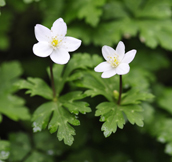
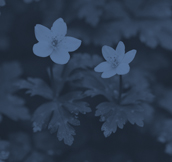 Anemone flaccida Ranunculaceae
Anemone flaccida Ranunculaceae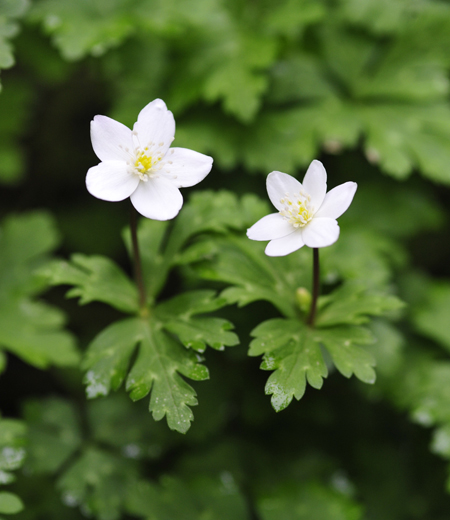 Perennial herbs (grow for several years from their same root system) found in sunny forest edge, forests and grasslands along streams in mountains. Bloom two flowers on a stem, hence the Japanese name Nirin-so literally meaning two flowers plants. In reality, many bloom only one or even three flowers. Prefer wet areas and often seen them in forests near waterside. It is very beautiful that the ground is covered with white flowers. Flowers are 2 cm in diameter and bloom on top of two flower stalks. Compare to anemone nikoensis, flowers look a lot smaller. Have five sepals look like petals which is mainly white but also have light red or green colored. Some have seven sepals. In the middle of a stem, three leaves grow without petioles.
Perennial herbs (grow for several years from their same root system) found in sunny forest edge, forests and grasslands along streams in mountains. Bloom two flowers on a stem, hence the Japanese name Nirin-so literally meaning two flowers plants. In reality, many bloom only one or even three flowers. Prefer wet areas and often seen them in forests near waterside. It is very beautiful that the ground is covered with white flowers. Flowers are 2 cm in diameter and bloom on top of two flower stalks. Compare to anemone nikoensis, flowers look a lot smaller. Have five sepals look like petals which is mainly white but also have light red or green colored. Some have seven sepals. In the middle of a stem, three leaves grow without petioles.
●Season Early April to Early May
●Height about 15 to 20 cm
●Place Trail 1, Trail 6, Jyataki, Ura-Takao, Oku-Takao, Minami-Takao, Kita-Takao -
Aquilegia adoxoides (Semiaquilegia adoxoides) Ranunculaceae
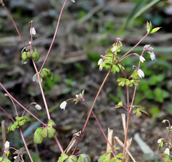
 Aquilegia adoxoides (Semiaquilegia adoxoides) Ranunculaceae
Aquilegia adoxoides (Semiaquilegia adoxoides) Ranunculaceae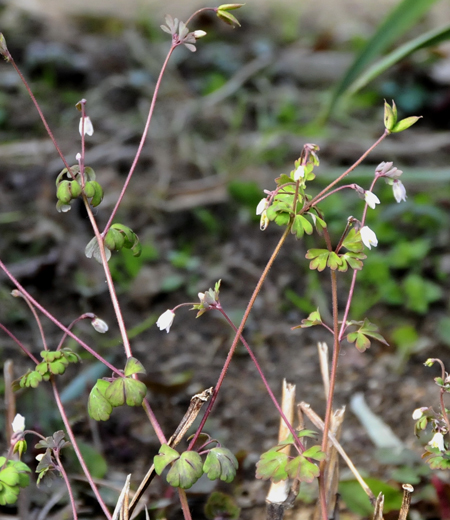 Perennial herbs (grow for several years from their same root system) found in sunny roadside, grasslands and space in rocky fences. The Japanese name Hime-uzu literally meaning small monkshood was named because leaves resemble monkshood and plant is short. Bloom small reddish white flowers on skinny stems. Flowers are 5 mm in diameter and dropping. Yellow petals are tubular inside of petal-looking bracts. Radical leaves (leaves grow from the roots) are covering ground. Leaves on stems have densely short hair. After flowering, stems grow upright and bear fruits. Split vertical and pop seeds when ripen.
Perennial herbs (grow for several years from their same root system) found in sunny roadside, grasslands and space in rocky fences. The Japanese name Hime-uzu literally meaning small monkshood was named because leaves resemble monkshood and plant is short. Bloom small reddish white flowers on skinny stems. Flowers are 5 mm in diameter and dropping. Yellow petals are tubular inside of petal-looking bracts. Radical leaves (leaves grow from the roots) are covering ground. Leaves on stems have densely short hair. After flowering, stems grow upright and bear fruits. Split vertical and pop seeds when ripen.
●Season Late March to Early May
●Height about 10 to 20 cm
●Place Ura-Takao, Minami-Takao -
Stellaria sessiliflora Caryophyllaceae
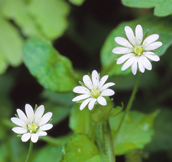
 Stellaria sessiliflora Caryophyllaceae
Stellaria sessiliflora Caryophyllaceae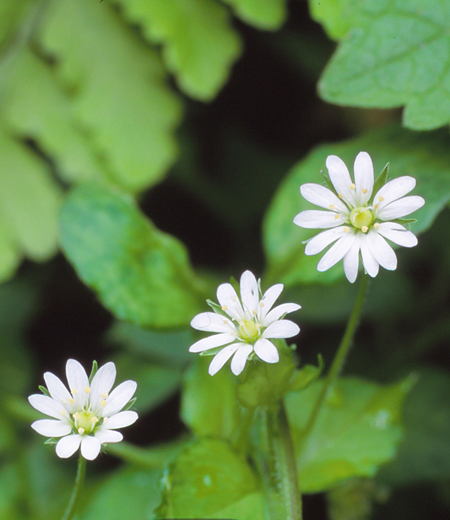 They are a perennial plant that thrive in humid shady places such sunny as in the pool of the forests, in the forests, and on the forest roads along the mountain streams (Perennial plant takes several years to grow). Their species have a very large flower among the group of Stellaria media. The white flower blossoms out upwards, thus, they distinguish themselves. One flower is about 1 to 1.5 cm in diameter on the stalk growing from the root of the leaf. They bear 5 flower petals, and each of them is split into 2, which makes them have 10 of flower petals. Sepal attached at the base of the flowers is sharp and a long white trichome grows outside. The leaf is wide egged-shaped like a spade, about 1 to 3.5 cm long, with the back carrying vellus along the leaf veins. The leaf grown from the bottom of the stalk has a long stem. Their characteristic is the stalk has usually 2 lines of trichome, which expands widespread like creeping on the ground.
They are a perennial plant that thrive in humid shady places such sunny as in the pool of the forests, in the forests, and on the forest roads along the mountain streams (Perennial plant takes several years to grow). Their species have a very large flower among the group of Stellaria media. The white flower blossoms out upwards, thus, they distinguish themselves. One flower is about 1 to 1.5 cm in diameter on the stalk growing from the root of the leaf. They bear 5 flower petals, and each of them is split into 2, which makes them have 10 of flower petals. Sepal attached at the base of the flowers is sharp and a long white trichome grows outside. The leaf is wide egged-shaped like a spade, about 1 to 3.5 cm long, with the back carrying vellus along the leaf veins. The leaf grown from the bottom of the stalk has a long stem. Their characteristic is the stalk has usually 2 lines of trichome, which expands widespread like creeping on the ground.
●Season Late April to about Late June
●Height about 20 to 30 cm
●Place Ura-Takao -
Aristolochia kaempferi Aristolochiaceae
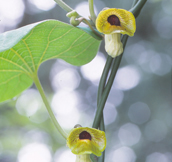
 Aristolochia kaempferi Aristolochiaceae
Aristolochia kaempferi Aristolochiaceae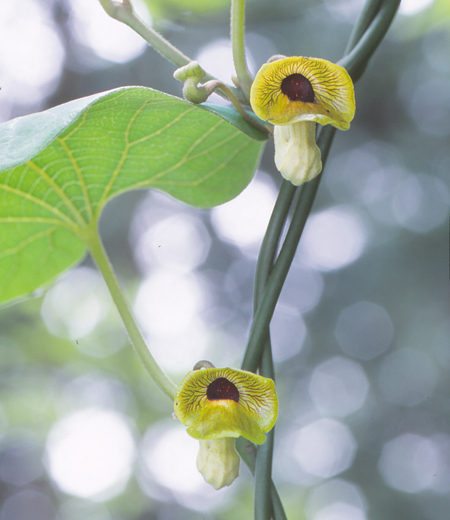 Vines grow in forests in mountains. Twine adjacent plant and bloom sax-shaped unique flowers. Fruits resemble aristolochia debilis and have large leaves, hence the Japanese name Oobano-umanosuzukusa literally meaning large leaves aristolochia debilis. Flowers are yellow, tubular sepals and no petals have purple stripe patterns inside. Leaves are wide, 8 to 15 cm long, heart shaped, thick texture and whitish on the back. Have hair on both sides but the one on the surface disappear as they grow. Is poisonous but caterpillars of Chinese windmill feed on the leaves in order to intake the poison to protect themselves from enemies. In autumn, fruits ripen to black and have full of seeds inside.
Vines grow in forests in mountains. Twine adjacent plant and bloom sax-shaped unique flowers. Fruits resemble aristolochia debilis and have large leaves, hence the Japanese name Oobano-umanosuzukusa literally meaning large leaves aristolochia debilis. Flowers are yellow, tubular sepals and no petals have purple stripe patterns inside. Leaves are wide, 8 to 15 cm long, heart shaped, thick texture and whitish on the back. Have hair on both sides but the one on the surface disappear as they grow. Is poisonous but caterpillars of Chinese windmill feed on the leaves in order to intake the poison to protect themselves from enemies. In autumn, fruits ripen to black and have full of seeds inside.
●Season Early May to Late May
●Height Vines
●Place Kita-Takao -
Asarum tamaense Aristolochiaceae
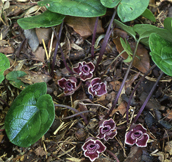
 Asarum tamaense Aristolochiaceae
Asarum tamaense Aristolochiaceae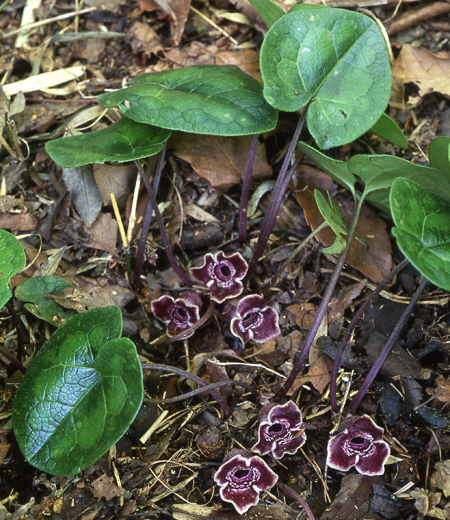 Perennial evergreen herbs (grow for several years from their same root system) found in forests from hills to mountains. The Japanese name Tamano-kan-aoi was named because it was first found on hills in Tama area (kan-aoi means asarum). Mt. Takao is the westernmost area of distribution and is valuable plant as not many grow in the area. Thick leaves are like tanned leather and sagged on leaf veins. The size is 5 to 10 cm, oval-like heart-shaped. Have long petioles and bloom 4 cm in diameter flowers at the base. This base is hidden underground, flowers sometimes looks like it is dropped on the ground. It is difficult to find because some flowers are half-covered with soils or covered with fallen leaves.
Perennial evergreen herbs (grow for several years from their same root system) found in forests from hills to mountains. The Japanese name Tamano-kan-aoi was named because it was first found on hills in Tama area (kan-aoi means asarum). Mt. Takao is the westernmost area of distribution and is valuable plant as not many grow in the area. Thick leaves are like tanned leather and sagged on leaf veins. The size is 5 to 10 cm, oval-like heart-shaped. Have long petioles and bloom 4 cm in diameter flowers at the base. This base is hidden underground, flowers sometimes looks like it is dropped on the ground. It is difficult to find because some flowers are half-covered with soils or covered with fallen leaves.
●Season Mid April to Mid May
●Height about 10 cm
●Place Iroha -
Asarum caulescens Aristolochiaceae
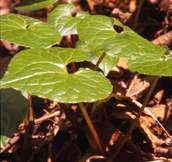
 Asarum caulescens Aristolochiaceae
Asarum caulescens Aristolochiaceae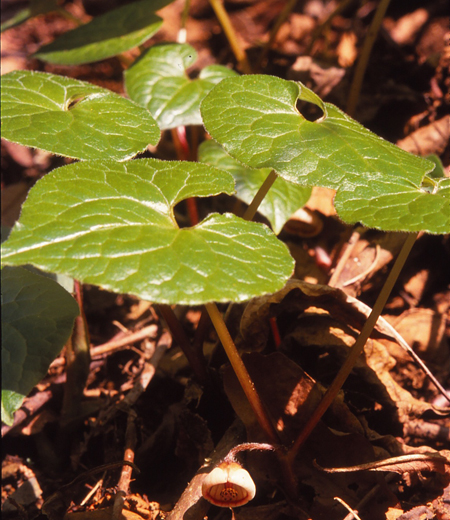 Perennial herbs (grow for several years from their same root system) found on forest floor in mountains. Stems grow along the ground. Two heart-shaped opposite leaves open on the long petioles grow from the tip of stem. Three leaves of this plant are designed in the family crest of Tokugawa family. Is also used in the festival at Kamo Shrine in Kyoto, hence another name is kamo-aoi (aoi is the name of this leaf). Leaves are 4 to 8 cm long and have white short hair on both sides. Flowers are 1.5 cm in diameter and dropping bell-shaped. Have no petals and sepals are curved outward. The color of flowers is purplish brown with white on outside. Bloom only one flower from a petiole and often covered with leaves.
Perennial herbs (grow for several years from their same root system) found on forest floor in mountains. Stems grow along the ground. Two heart-shaped opposite leaves open on the long petioles grow from the tip of stem. Three leaves of this plant are designed in the family crest of Tokugawa family. Is also used in the festival at Kamo Shrine in Kyoto, hence another name is kamo-aoi (aoi is the name of this leaf). Leaves are 4 to 8 cm long and have white short hair on both sides. Flowers are 1.5 cm in diameter and dropping bell-shaped. Have no petals and sepals are curved outward. The color of flowers is purplish brown with white on outside. Bloom only one flower from a petiole and often covered with leaves.
●Season Mid April to Mid May
●Height about 8 to 15 cm
●Place Ura-Takao -
Elatostema umbellatum var. majus Urticaceae
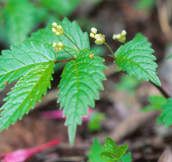
 Elatostema umbellatum var. majus Urticaceae
Elatostema umbellatum var. majus Urticaceae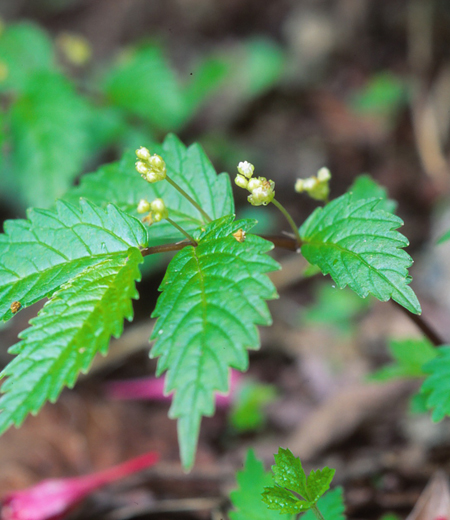 Perennial herbs (grow for several years from their same root system) found in wet areas including streamside, roadside and slopes. The Japanese name Uwabami-so literally meaning large sized snake plant was named because many of them grow in the areas where large snake lives. Is also often called as Mizu or Mizuna literally meaning water or water plants because it contains a lot of moisture. Stems are reddish with asymmetric leaf. Leaves are 4 to 10 cm long, oval-shaped with toothed margins (edges of leaves are like a teeth of saw) and have hairs on both sides. Bloom small flowers in clusters on a peduncle grow from a petiole. In autumn, sprout become round-shaped with nutrients called Mukago (bulblet).
Perennial herbs (grow for several years from their same root system) found in wet areas including streamside, roadside and slopes. The Japanese name Uwabami-so literally meaning large sized snake plant was named because many of them grow in the areas where large snake lives. Is also often called as Mizu or Mizuna literally meaning water or water plants because it contains a lot of moisture. Stems are reddish with asymmetric leaf. Leaves are 4 to 10 cm long, oval-shaped with toothed margins (edges of leaves are like a teeth of saw) and have hairs on both sides. Bloom small flowers in clusters on a peduncle grow from a petiole. In autumn, sprout become round-shaped with nutrients called Mukago (bulblet).
●Season Late April to Early June
●Height about 20 to 30 cm
●Place Trail 1, Trail 3 and 4, Trail 6, Ura-Takao, Oku-Takao -
Nanocnide japonica Urticaceae
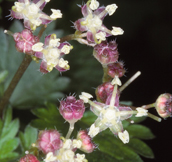
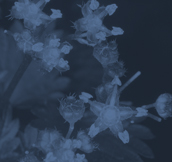 Nanocnide japonica Urticaceae
Nanocnide japonica Urticaceae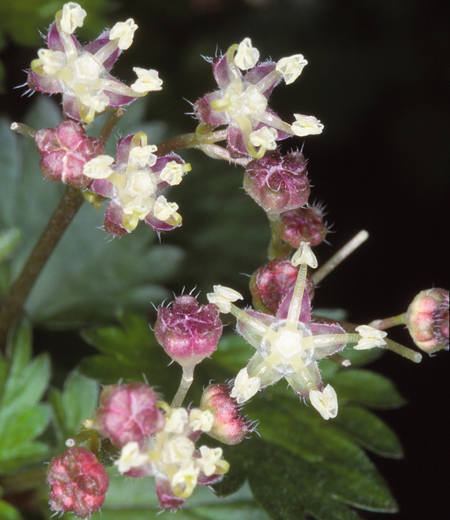 Perennial herbs (grow for several years from their same root system) grow covering the ground found in tree shades in mountains. Bloom small light purple flowers in early spring but they are too small to notice unless taking a closer look. Most of plants bloom various shaped flowers for insects to pollinate. For this plant, it is believed that flowers do not have to be too distinct because it pollinate by winds. Flowers are male and female flowers and male flowers are in clusters on the upper part of stem and female flowers are at the base of stem. Leaves are about 3 cm long, triangle-like egg-shaped with toothed margins (edges of leaves are like a teeth of saw) and shiny texture.
Perennial herbs (grow for several years from their same root system) grow covering the ground found in tree shades in mountains. Bloom small light purple flowers in early spring but they are too small to notice unless taking a closer look. Most of plants bloom various shaped flowers for insects to pollinate. For this plant, it is believed that flowers do not have to be too distinct because it pollinate by winds. Flowers are male and female flowers and male flowers are in clusters on the upper part of stem and female flowers are at the base of stem. Leaves are about 3 cm long, triangle-like egg-shaped with toothed margins (edges of leaves are like a teeth of saw) and shiny texture.
●Season March to April
●Height about 10 to 30 cm
●Place Trail 1, Trail 3 and 4, Trail 6, Ura-Takao, Oku-Takao -
Chloranthus japonicus Chloranthaceae
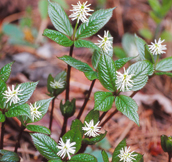
 Chloranthus japonicus Chloranthaceae
Chloranthus japonicus Chloranthaceae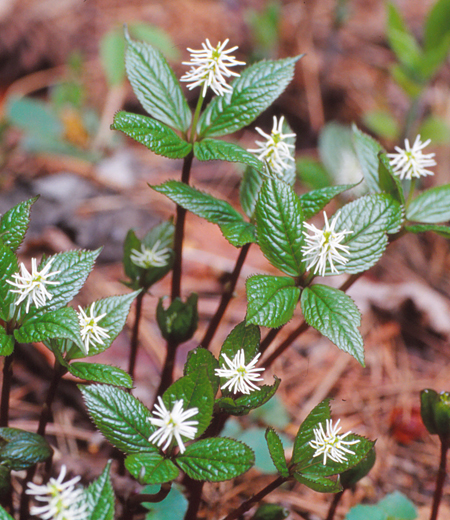 They are a perennial plant that grows at such places as under the forests or at the grasslands at the base of a mountain district and on the mountain. (Perennial plant takes several years to grow). 4 leaves grow on the stalk like covering the stalk and 1 white inflorescence (Kajo: arrangement of flowers on a stalk) stands still from the center. The name derivation of ‘Chloranthus japonicus’ (Hitori-Shizuka) comes from their elegant appearance which is compared as courtly Shizukagozen (one of the most famous women in Japanese history court dancer of the 12th century). The inflorescence is about 3 cm long and like white brush. Their characteristic is the white potion of inflorescence is a male stamen and they don’t have the flower petals or calyx. The stalk grows upstraight. When it begins to grow, it is tinged with dark green with a sharp sawtooth at the edge (Kyoshi: tooth-like rough part like a saw at the root of a leaf) at the edge. When the flowers wither, they bear the rounded seeds about 2.3 to 3 mm in diameter.
They are a perennial plant that grows at such places as under the forests or at the grasslands at the base of a mountain district and on the mountain. (Perennial plant takes several years to grow). 4 leaves grow on the stalk like covering the stalk and 1 white inflorescence (Kajo: arrangement of flowers on a stalk) stands still from the center. The name derivation of ‘Chloranthus japonicus’ (Hitori-Shizuka) comes from their elegant appearance which is compared as courtly Shizukagozen (one of the most famous women in Japanese history court dancer of the 12th century). The inflorescence is about 3 cm long and like white brush. Their characteristic is the white potion of inflorescence is a male stamen and they don’t have the flower petals or calyx. The stalk grows upstraight. When it begins to grow, it is tinged with dark green with a sharp sawtooth at the edge (Kyoshi: tooth-like rough part like a saw at the root of a leaf) at the edge. When the flowers wither, they bear the rounded seeds about 2.3 to 3 mm in diameter.
●Season Early April to about Early May
●Height about 10 to 15 cm
●Place Ura-Takao, Oku-Takao ,Minami-Takao -
Chloranthus serratus Chloranthaceae
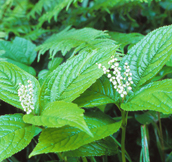
 Chloranthus serratus Chloranthaceae
Chloranthus serratus Chloranthaceae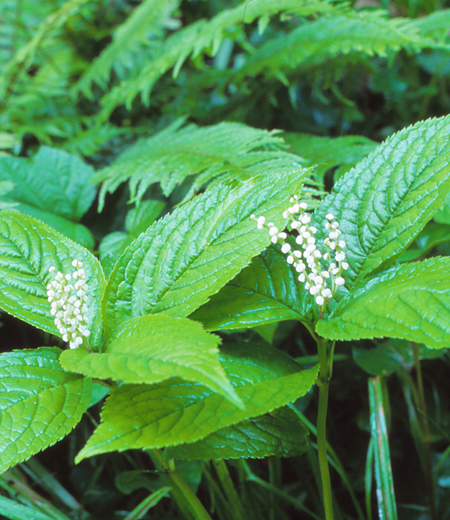 They are a perennial plant that grows in the pool of the forests and in the forests in a mountain district and on the mountain. (Perennial plant takes several years to grow).
They are a perennial plant that grows in the pool of the forests and in the forests in a mountain district and on the mountain. (Perennial plant takes several years to grow).
They grow 2 inflorescences (Kajo: arrangement of flowers on a stalk), and this is why they are named ‘Chloranthus serratus’ (Hutari-Shizuka) compared to Chloranthus japonicus. 4 leaves in two pairs at the upper portion of the stalk expand at small intervals with inflorescences with a little white flower about 2 to 5 cm long sprouting in the center. Many produce 2 sprouting, while some do 3 to 5. What seems to be white is all a male stamen and has no flower petals or calyxes. The male stamen is not filiform shape unlike Chloranthus japonicus but rice grain shape that 3 male stamens hold to cover female stamens. The leaves are elliptically-shaped about 8 to 16 mm, not shiny, with a sharp sawtooth at the edge (Kyoshi: tooth-like rough part like a saw at the root of a leaf) at the edge. During the summer to the autumn, cleistogamous flower develops which is not open for pollination.
●Season Late May to about Late June
●Height about 30 to 50 cm
●Place Trail 3, Ura-Takao, Oku-Takao -
Calanthe discolor Orchidaceae
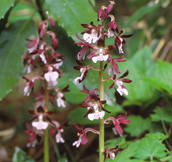
 Calanthe discolor Orchidaceae
Calanthe discolor Orchidaceae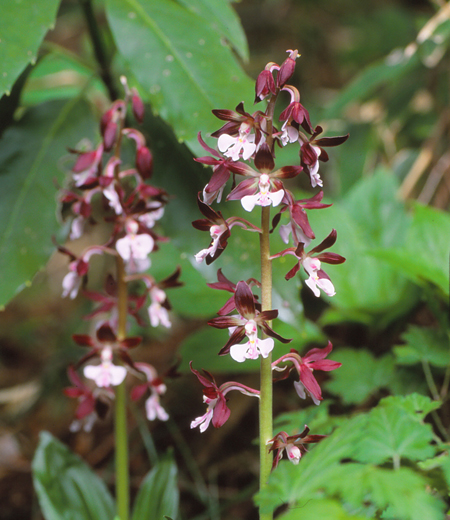 They are perennial plant that grows in the cops and bamboo thickets (perennial plant takes several years to grow).10 to 20 flowers bloom a bit among them at the top of straight stalk. The number is decreasing due to illegally digging up plants for gardening. The underground stem has rounded knots extended in a row, which resembles stooping shrimps. This is how they are named ‘Calanthe discolor’ (Ebine). The flower is about 2 to 3 cm in diameter with three flower petals and three sepals. Flower petals on the bottom are divided widely and usually pale red or white. Though flower petals and sepals are olive-brown, there is a large individual variation. Radical leaf (Konseiyou: eaves springing up at the root of the stem) is an elliptical shape about 10 to 30 cm long, 5 to 8 cm wide. 3 to 5 of radical leaf grow from the root and come up like wrapping up the stalk. Leaves remain still there even in winter, but when it is time to bloom and new leaves sprout, the older ones wither.
They are perennial plant that grows in the cops and bamboo thickets (perennial plant takes several years to grow).10 to 20 flowers bloom a bit among them at the top of straight stalk. The number is decreasing due to illegally digging up plants for gardening. The underground stem has rounded knots extended in a row, which resembles stooping shrimps. This is how they are named ‘Calanthe discolor’ (Ebine). The flower is about 2 to 3 cm in diameter with three flower petals and three sepals. Flower petals on the bottom are divided widely and usually pale red or white. Though flower petals and sepals are olive-brown, there is a large individual variation. Radical leaf (Konseiyou: eaves springing up at the root of the stem) is an elliptical shape about 10 to 30 cm long, 5 to 8 cm wide. 3 to 5 of radical leaf grow from the root and come up like wrapping up the stalk. Leaves remain still there even in winter, but when it is time to bloom and new leaves sprout, the older ones wither.
●Season Mid April to about Mid May
●Height about 30 to 40 cm
●Place Oku-Takao -
Cephalanthera falcate Orchidaceae
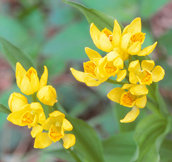
 Cephalanthera falcate Orchidaceae
Cephalanthera falcate Orchidaceae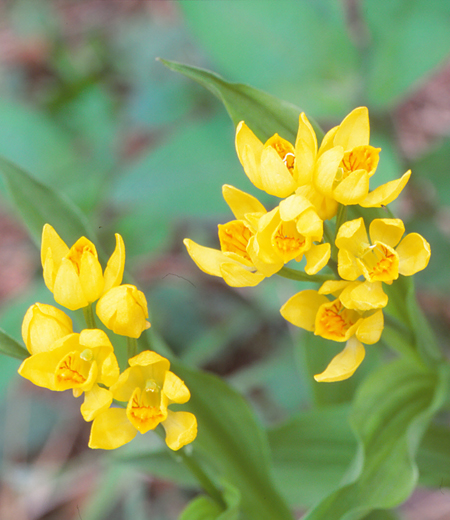 They are perennial plant that grows in the sunny copse of mountain districts and hills (perennial plant takes several years to grow). As the number of mountain districts are decreasing, so are they, thus they are one of rare orchids that we can see at Mt. Takao. They bear brilliant yellow flowers and this is why they are named ‘Cephalanthera falcata’. The flower is 1 to 1.5 cm in diameter. 3 to 12 flowers bloom a bit upward at the top of stalk. Few of flowers are fully open while most of them are half-open. The flower petal and calyx are almost same in color. The bottommost flower petal is tubulous at the root and inside has 5 to 7 dark brown projections called ‘ridge’. The leaf looks like bamboo grass, is about 8 to 15 cm long and 2 to 4.5 cm wide, has longitudinal wrinkles, and grows alternate as if they are wrapping the stalk. The underground stem spreads deep inside of the ground.
They are perennial plant that grows in the sunny copse of mountain districts and hills (perennial plant takes several years to grow). As the number of mountain districts are decreasing, so are they, thus they are one of rare orchids that we can see at Mt. Takao. They bear brilliant yellow flowers and this is why they are named ‘Cephalanthera falcata’. The flower is 1 to 1.5 cm in diameter. 3 to 12 flowers bloom a bit upward at the top of stalk. Few of flowers are fully open while most of them are half-open. The flower petal and calyx are almost same in color. The bottommost flower petal is tubulous at the root and inside has 5 to 7 dark brown projections called ‘ridge’. The leaf looks like bamboo grass, is about 8 to 15 cm long and 2 to 4.5 cm wide, has longitudinal wrinkles, and grows alternate as if they are wrapping the stalk. The underground stem spreads deep inside of the ground.
●Season Late April to about Late May
●Height about 30 to 60 cm
●Place Ura-Takao,Oku-Takao -
Cephalanthera erecta Orchidaceae
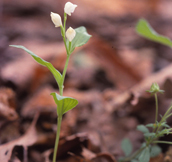
 Cephalanthera erecta Orchidaceae
Cephalanthera erecta Orchidaceae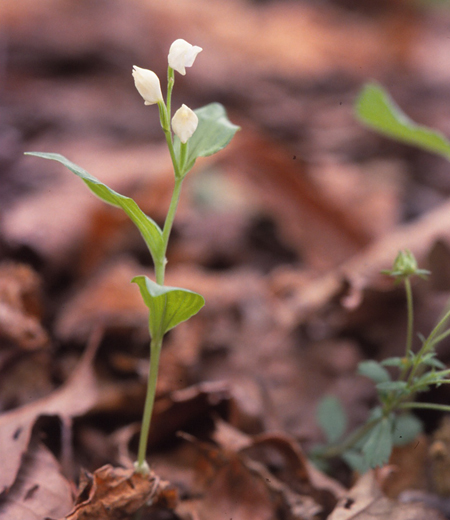 They are perennial plant that grows in the sunny copse of mountain districts and hills (perennial plant takes several years to grow). They are rare species we seldom see at Mt. Takao. While Cephalanthera falcate bears yellow flowers, their flowers are white. This is why they are named Cephalanthera erecta. The flower is about 1.5 to 2 cm in diameter. 5 to 10 flowers bloom on the top of stalk and most of the flower petals are half-open. They have 3 flower petals and 3 calyxes and there is yellow ‘costa’ (Ryukisenn) inside of the centered flower petal. The leaf looks like bamboo grass, is about 3 to 8 cm long and 1 to 2.5 cm wide, 5 to 6 leaves grow alternate as if they are wrapping the stalk. In the case of very similar Cephalanthera longibracteata, bract leaf (Houyou: transformed leaf at the root of flower stalk) just below the flower grow higher than flowers. On the contrary, in the case of Cephalanthera erecta, the bract leaf is short. This is a good point to distinguish one from another.
They are perennial plant that grows in the sunny copse of mountain districts and hills (perennial plant takes several years to grow). They are rare species we seldom see at Mt. Takao. While Cephalanthera falcate bears yellow flowers, their flowers are white. This is why they are named Cephalanthera erecta. The flower is about 1.5 to 2 cm in diameter. 5 to 10 flowers bloom on the top of stalk and most of the flower petals are half-open. They have 3 flower petals and 3 calyxes and there is yellow ‘costa’ (Ryukisenn) inside of the centered flower petal. The leaf looks like bamboo grass, is about 3 to 8 cm long and 1 to 2.5 cm wide, 5 to 6 leaves grow alternate as if they are wrapping the stalk. In the case of very similar Cephalanthera longibracteata, bract leaf (Houyou: transformed leaf at the root of flower stalk) just below the flower grow higher than flowers. On the contrary, in the case of Cephalanthera erecta, the bract leaf is short. This is a good point to distinguish one from another.
●Season Early April to about Late May
●Height about 10 to 30 cm
●Place Trail 5 -
Cymbidium goeringii(Riverstream orchid) Orchidaceae
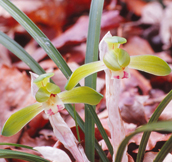
 Cymbidium goeringii(Riverstream orchid) Orchidaceae
Cymbidium goeringii(Riverstream orchid) Orchidaceae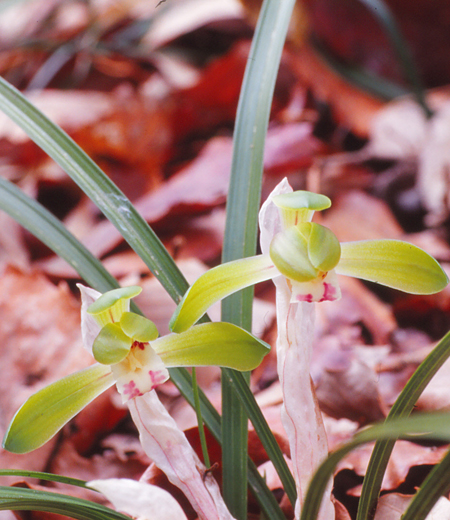 They are perennial plant that grows in the sunny and arid copse (perennial plant takes several years to grow). This is also one of the rare, decreasing species at Mt. Takao. As Chinese name ‘Syun-ran’ shows it, they are earliest in the bloom in the spring among the group of Orchidaceae. The flower is 3 to 3.5 cm in diameter and usually bloom at the top of flower stalk (Kakei: stalk that can have flowers without leaves). The side-valve and calyx of the flower are yellow-green. The bottommost flower petal has pattern mottles of blood red, which resemble face mole or mottled face. This is why they are also called ‘dark mole’ or ‘JiJi-BaBa’ (Aged people or grandfather/grandmother) . Flower stalk is covered with the transparent scale leaf (Rinpen: transformed leaf into scale-like) and chylocaulous and thick. The leaf is thin about 20 to 35 cm long and 0.6 to 1 cm wide. Leaves are hard and rough to touch with sawtooth at the edge. Lots of green leaves sprout from the root all year round so well that they stand out nice even early in the spring.
They are perennial plant that grows in the sunny and arid copse (perennial plant takes several years to grow). This is also one of the rare, decreasing species at Mt. Takao. As Chinese name ‘Syun-ran’ shows it, they are earliest in the bloom in the spring among the group of Orchidaceae. The flower is 3 to 3.5 cm in diameter and usually bloom at the top of flower stalk (Kakei: stalk that can have flowers without leaves). The side-valve and calyx of the flower are yellow-green. The bottommost flower petal has pattern mottles of blood red, which resemble face mole or mottled face. This is why they are also called ‘dark mole’ or ‘JiJi-BaBa’ (Aged people or grandfather/grandmother) . Flower stalk is covered with the transparent scale leaf (Rinpen: transformed leaf into scale-like) and chylocaulous and thick. The leaf is thin about 20 to 35 cm long and 0.6 to 1 cm wide. Leaves are hard and rough to touch with sawtooth at the edge. Lots of green leaves sprout from the root all year round so well that they stand out nice even early in the spring.
●Season Late March to about Late April
●Height about 15 to 25 cm
●Place Trail 5, Mt.Inari, Ura-Takao, Oku-Takao, Minami-Takao -
Dendrobium moniliforme Orchidaceae
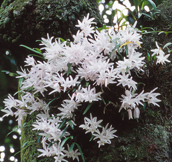
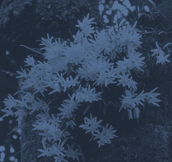 Dendrobium moniliforme Orchidaceae
Dendrobium moniliforme Orchidaceae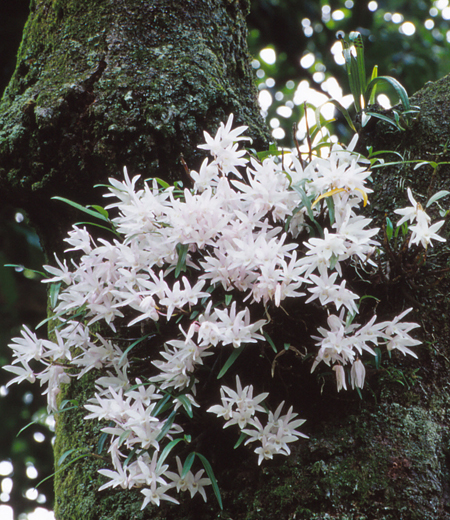 They are perennial plant that grows at forests or on the rocks in the humid places along mountain stream (perennial plant takes several years to grow). They grow on old trees in Mt. Takao and bear beautiful blossoms. After leaves are fallen, the stalk develops peduncle from its knots and bear 1 to 2 flowers. The flower is 3 to 4 cm long in diameter, whitish pale pink color. They smell the sweet smell of flowers. The bottommost flower petal has short glandular trichome inside at the root. The leaf is 3 to 5 cm long, thick and slightly shiny, and continues to grow at the stalk for 2 to 3 years. The stalk consists of stalk-fascicle at the root, has vertically striped stem and numerous knots. Japanese name is “sekoku” which in the literature shows they have been renowned for efficacy for stomachic property, anti-inflammatory action, and tonic property, so that they have been utilized as Chinese herbal remedy.
They are perennial plant that grows at forests or on the rocks in the humid places along mountain stream (perennial plant takes several years to grow). They grow on old trees in Mt. Takao and bear beautiful blossoms. After leaves are fallen, the stalk develops peduncle from its knots and bear 1 to 2 flowers. The flower is 3 to 4 cm long in diameter, whitish pale pink color. They smell the sweet smell of flowers. The bottommost flower petal has short glandular trichome inside at the root. The leaf is 3 to 5 cm long, thick and slightly shiny, and continues to grow at the stalk for 2 to 3 years. The stalk consists of stalk-fascicle at the root, has vertically striped stem and numerous knots. Japanese name is “sekoku” which in the literature shows they have been renowned for efficacy for stomachic property, anti-inflammatory action, and tonic property, so that they have been utilized as Chinese herbal remedy.
●Season Mid May to about Late June
●Height about 10 to 30 cm
●Place Trail 1 , Trail 6 -
Iris japonica Iridaceae
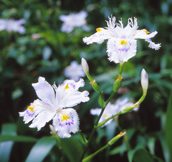
 Iris japonica Iridaceae
Iris japonica Iridaceae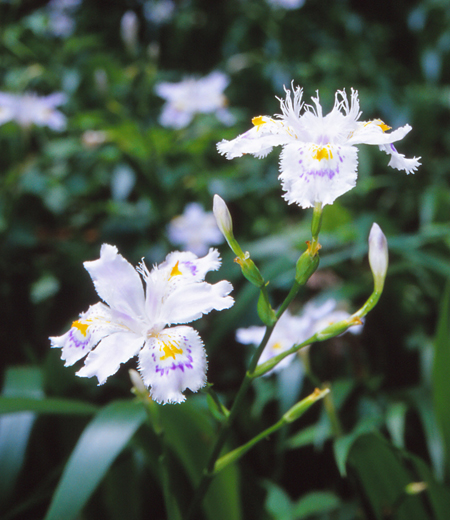 Perennial evergreen herbs (grow for several years from their same root system) found at streamside, in forests and forest edges from the foot of mountains to a mountain peak. Grow by extending rhizomes because they are unable to produce seeds. Taking advantage of this characteristic, often planted as a retaining wall on riverbank. Flowers are 4 to 6 cm in diameter, bloom in the morning and wither in late afternoon. Are finely lobed on edges and light purple with purple and orange patterns on outer petals are beautiful. Blooming season is long and blooming in clumps is striking. Often find the clusters in many places in Mt. Takao. Leaves are sword-shaped, 30 to 60 cm long, shiny surface and bright green.
Perennial evergreen herbs (grow for several years from their same root system) found at streamside, in forests and forest edges from the foot of mountains to a mountain peak. Grow by extending rhizomes because they are unable to produce seeds. Taking advantage of this characteristic, often planted as a retaining wall on riverbank. Flowers are 4 to 6 cm in diameter, bloom in the morning and wither in late afternoon. Are finely lobed on edges and light purple with purple and orange patterns on outer petals are beautiful. Blooming season is long and blooming in clumps is striking. Often find the clusters in many places in Mt. Takao. Leaves are sword-shaped, 30 to 60 cm long, shiny surface and bright green.
●Season Mid April to Late May
●Height about 50 to 60 cm
●Place Trail 1 to 6, Mt. Inari, Jyataki, Ura-Takao, Iroha ,Oku-Takao -
Polygonatum odoratum var. pluriflorum Liliaceae
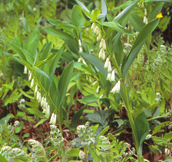
 Polygonatum odoratum var. pluriflorum Liliaceae
Polygonatum odoratum var. pluriflorum Liliaceae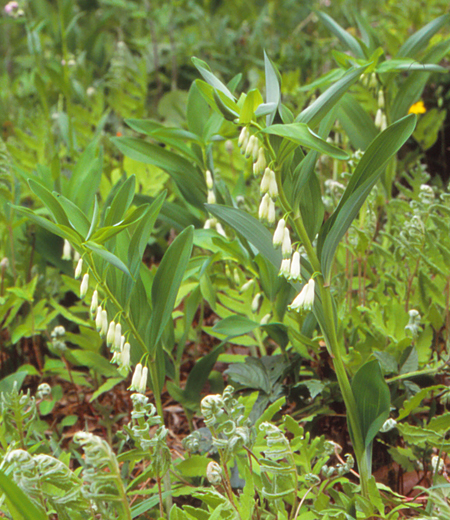 They are perennial plant that grows at a sunny forest, grassland, and roadside (perennial plant takes several years to grow). Their thick underground stem looks like Dioscorea tokoro Makino (Araceae) and sweet and tasty to eat. This is how they are named. Their characteristics are they have vertically striped stem and the stem are angulated. These help us to tell which one is Polygonatum falcatum. The leaf is about 5 to 10 cm long, about 2 to 5 cm wide elliptically-shaped, and the back of it is white like being flour-coated. A couple of flowers cast down underneath from the root portion of the leaf.
They are perennial plant that grows at a sunny forest, grassland, and roadside (perennial plant takes several years to grow). Their thick underground stem looks like Dioscorea tokoro Makino (Araceae) and sweet and tasty to eat. This is how they are named. Their characteristics are they have vertically striped stem and the stem are angulated. These help us to tell which one is Polygonatum falcatum. The leaf is about 5 to 10 cm long, about 2 to 5 cm wide elliptically-shaped, and the back of it is white like being flour-coated. A couple of flowers cast down underneath from the root portion of the leaf.
The flowers are about 1.5 to 2 cm long tubular corolla, and the tip of the flower petals are tinged with yellow-green. When the tip of the leaf is rolled up as new sprouts, we can enjoy eating new sprouts as Tempura and boiled leaves (Ohitashi), which are crunchy and sweet to eat. Dried underground stem can be utilized as a tonic.
●Season Early May to about Late May
●Height about 30 to 60 cm
●Place Trail 1, Trail 4, Jyataki, Ura-Takao,Oku-Takao -
Trillium smallii Liliaceae
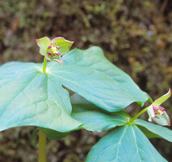
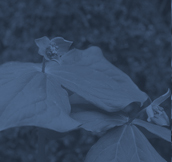 Trillium smallii Liliaceae
Trillium smallii Liliaceae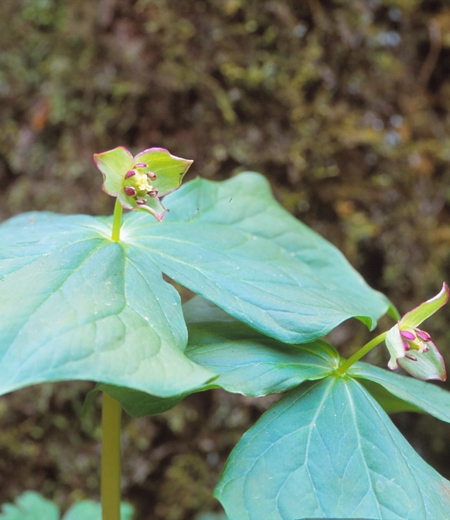 They are perennial plant that grows at the pool of humid forests along mountain stream or shades of tree (perennial plant takes several years to grow). What’s impressive is that a large leaf grows from the upright straight stalk as if the leaf is wearing a cloak. From the center comes out to bloom one flower like being pushed out from the center. The flower color varies from green to black tea color, and there are many green color ones at Mt. Takao. They have no flower petals, instead 1.5 to 2 cm long calyxes are open. The leaves are extensive egg-shaped with the tip sharp, about 10 to 15 cm long/wide, and three leaves develop like embracing the stalk. In China, people have utilized the underground stems of this plant after dried as Chinese herbal medicine named ‘Trillium apetalon’ (Enrenkonsou). This is how this plant is named. All parts of this plant, however, contain poisonous substance if taken by mistake the symptoms of acute vomiting. We need to be careful.
They are perennial plant that grows at the pool of humid forests along mountain stream or shades of tree (perennial plant takes several years to grow). What’s impressive is that a large leaf grows from the upright straight stalk as if the leaf is wearing a cloak. From the center comes out to bloom one flower like being pushed out from the center. The flower color varies from green to black tea color, and there are many green color ones at Mt. Takao. They have no flower petals, instead 1.5 to 2 cm long calyxes are open. The leaves are extensive egg-shaped with the tip sharp, about 10 to 15 cm long/wide, and three leaves develop like embracing the stalk. In China, people have utilized the underground stems of this plant after dried as Chinese herbal medicine named ‘Trillium apetalon’ (Enrenkonsou). This is how this plant is named. All parts of this plant, however, contain poisonous substance if taken by mistake the symptoms of acute vomiting. We need to be careful.
●Season Mid April to about Early May
●Height about 20 to 40 cm
●Place Trail 1,Ura-Takao -
Erythronium japonicum(Dogtooth Violet) Liliaceae
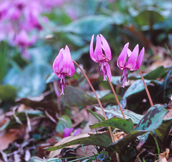
 Erythronium japonicum(Dogtooth Violet) Liliaceae
Erythronium japonicum(Dogtooth Violet) Liliaceae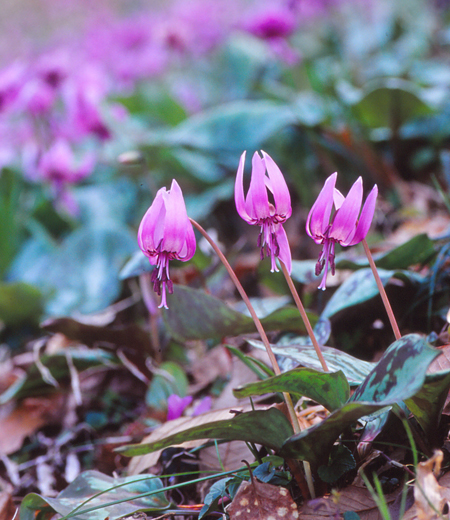 They are perennial plant that grows in sunny deciduous broadleaf forest (perennial plant takes several years to grow), and there is a mass place at the southern part of Takao, where Erythronium japonicum grow in clusters. They grow up at forests before the leaves sprout as well as they wither to disappear before the other plants nurture. They are called ‘Spring Ephemeral’ and this plant is typical one of hills/fields grasses. The leaves are long elliptical shape about 6 to 12 cm with long stalk, usually two. Leaves are thick and soft and usually have violet patterns on its surface. One pale red flower bloom downward at the top of flower stalk (Kakei: stem of flower bearing only flowers without leaves). The flower has 6 petals, which are about 4 to 5 cm long and rolling upward widely. Their name ‘Erythronium japonicum’ (Katakuri) comes from how this plant was written as Katakagono-Hana in "Man-yo-shu", which is one of the most renowned collection of poems at 8th century. The underground stem contains much starch, which was made into Potato Starch.
They are perennial plant that grows in sunny deciduous broadleaf forest (perennial plant takes several years to grow), and there is a mass place at the southern part of Takao, where Erythronium japonicum grow in clusters. They grow up at forests before the leaves sprout as well as they wither to disappear before the other plants nurture. They are called ‘Spring Ephemeral’ and this plant is typical one of hills/fields grasses. The leaves are long elliptical shape about 6 to 12 cm with long stalk, usually two. Leaves are thick and soft and usually have violet patterns on its surface. One pale red flower bloom downward at the top of flower stalk (Kakei: stem of flower bearing only flowers without leaves). The flower has 6 petals, which are about 4 to 5 cm long and rolling upward widely. Their name ‘Erythronium japonicum’ (Katakuri) comes from how this plant was written as Katakagono-Hana in "Man-yo-shu", which is one of the most renowned collection of poems at 8th century. The underground stem contains much starch, which was made into Potato Starch.
●Season Late March to about Early April
●Height about 10 to 20 cm
●Place Minami-Takao,Kita-Takao -
Gagea lutea Liliaceae
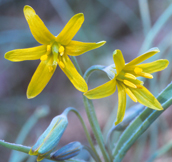
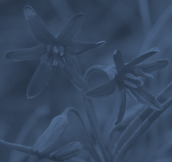 Gagea lutea Liliaceae
Gagea lutea Liliaceae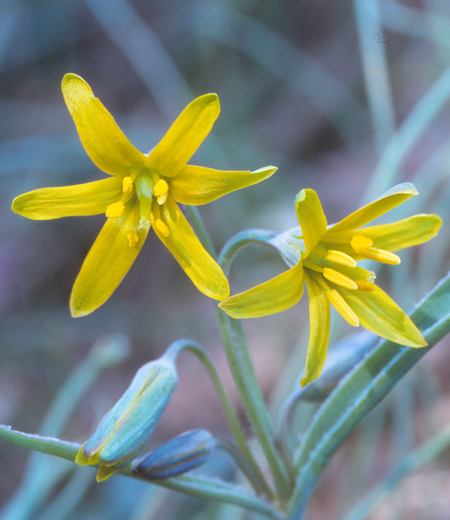 They are perennial plant that grows in sunny deep pool of forests in the mountain areas and at grasslands (perennial plant takes several years to grow). Gagea lutea bear yellow flowers like Amana edulis of the same Liliaceae group. This is why they are named Gagea lutea. While Amana edulis bear only one flower at the top of stalk, Gagea lutea carry several flowers on the top of the stalk, 10 at most. The flower is about 2 to 2.5 cm in diameter with 6 flower petals. Inside of the petals, it’s yellow and outside of it it’s green. Just below the flower, green small bract (Houyou: protecting an inflorescence). The peduncles (stalk bearing an inflorescence) vary in length but about 1 to 5 cm. Flowers bloom only when it’ a clear day, while close when it’s rainy or cloudy. One radical leaf (KON-SEI-YO: leaf spring up from the place about stalk root) is about 15 to 20 cm long and thin, grows higher than flower stalk (Kakei: stalk that can have flowers without leaves). Flower stalk is slightly thick, whitish green. When the flowers wither, they bear spherical seeds about 7 mm long.
They are perennial plant that grows in sunny deep pool of forests in the mountain areas and at grasslands (perennial plant takes several years to grow). Gagea lutea bear yellow flowers like Amana edulis of the same Liliaceae group. This is why they are named Gagea lutea. While Amana edulis bear only one flower at the top of stalk, Gagea lutea carry several flowers on the top of the stalk, 10 at most. The flower is about 2 to 2.5 cm in diameter with 6 flower petals. Inside of the petals, it’s yellow and outside of it it’s green. Just below the flower, green small bract (Houyou: protecting an inflorescence). The peduncles (stalk bearing an inflorescence) vary in length but about 1 to 5 cm. Flowers bloom only when it’ a clear day, while close when it’s rainy or cloudy. One radical leaf (KON-SEI-YO: leaf spring up from the place about stalk root) is about 15 to 20 cm long and thin, grows higher than flower stalk (Kakei: stalk that can have flowers without leaves). Flower stalk is slightly thick, whitish green. When the flowers wither, they bear spherical seeds about 7 mm long.
●Season Late March to about Mid April
●Height about 15 to 20 cm
●Place Ura-Takao -
Disporum smilacinum Liliaceae
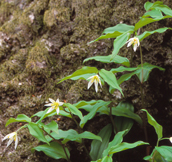
 Disporum smilacinum Liliaceae
Disporum smilacinum Liliaceae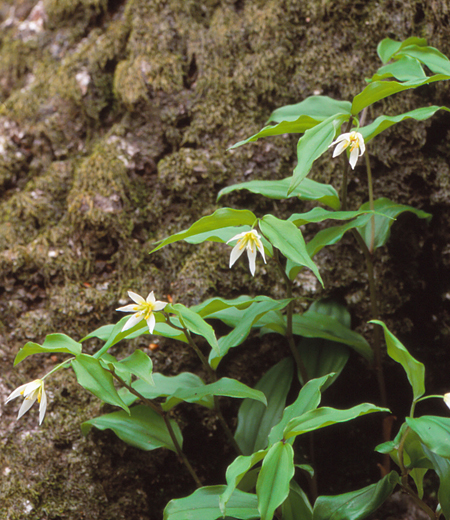 They are perennial plant that grows under the bright forests in the mountain areas (perennial plant takes several years to grow). They extend underground stems transversely, growing volubile stems to increase. 1 to 2 of white flowers bloom dangling obliquely downward at the top of stem. We can see rarely 3 of white flower at the branched stem. The appearance of small blooming flower is like bowing as if the infants bow people. This is how they are named. The flower is about 2 cm in diameter with 6 flower petals and the tip being sharp. The leaf is elliptical shape about 4 to 7 cm with the tip acuate, thin, glossy and looks like bamboo grass. After the flowers wither, they bear rounded seed about 1 cm in diameter. When the seed gets matured, it turns into black. As ‘Disporum x hishiyamanum’ is a natural hybrid between Disporum sessile and Disporum smilacinum, it is discovered for the first time as intermediate type of the two in 1984 at Mt. Takao.
They are perennial plant that grows under the bright forests in the mountain areas (perennial plant takes several years to grow). They extend underground stems transversely, growing volubile stems to increase. 1 to 2 of white flowers bloom dangling obliquely downward at the top of stem. We can see rarely 3 of white flower at the branched stem. The appearance of small blooming flower is like bowing as if the infants bow people. This is how they are named. The flower is about 2 cm in diameter with 6 flower petals and the tip being sharp. The leaf is elliptical shape about 4 to 7 cm with the tip acuate, thin, glossy and looks like bamboo grass. After the flowers wither, they bear rounded seed about 1 cm in diameter. When the seed gets matured, it turns into black. As ‘Disporum x hishiyamanum’ is a natural hybrid between Disporum sessile and Disporum smilacinum, it is discovered for the first time as intermediate type of the two in 1984 at Mt. Takao.
●Season Mid April to about Late May
●Height about 15 to 30 cm
●Place Trail 1 to 6,Mt.Inari,Jyataki,Iroha,Ura-Takao,Oku-Takao, Kita-Takao -
Polygonatum falcatum Liliaceae
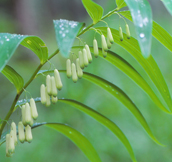
 Polygonatum falcatum Liliaceae
Polygonatum falcatum Liliaceae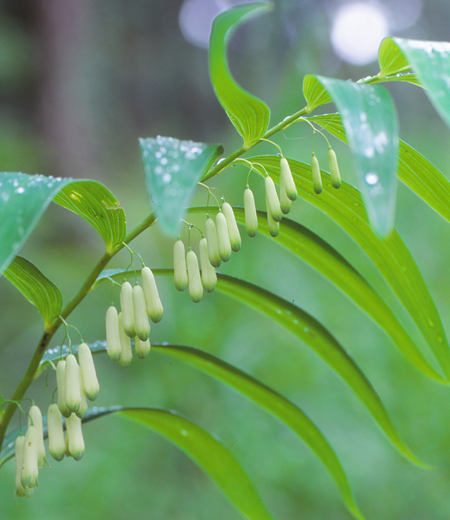 They are perennial plant that grows at a sunny forest, grassland, and roadside (perennial plant takes several years to grow). From the curving stem like bow, numerous white tubular flowers are dangling. The scenery is similar to ‘Naruko’ which people hang from the rope to scare sparrow away in the rice field. This is how this plant is named. Flowers are dangling from the root of the leaf with 3 to 5 ones in one row, about 2 cm long, and the tip of the flower is dark green. The leaves are about 8 to 15 cm long, 1 to 2.5 cm wide, look like rather long and narrow bamboo grass. Leafstalk (Youhei) is short, grows alternate on the stalk with most of new leaves white-striped. Though they resemble the same group Polygonatum odoratum, the difference is good characteristic to distinguish from, such as lots of flowers and sphere-shaped smooth stalk.
They are perennial plant that grows at a sunny forest, grassland, and roadside (perennial plant takes several years to grow). From the curving stem like bow, numerous white tubular flowers are dangling. The scenery is similar to ‘Naruko’ which people hang from the rope to scare sparrow away in the rice field. This is how this plant is named. Flowers are dangling from the root of the leaf with 3 to 5 ones in one row, about 2 cm long, and the tip of the flower is dark green. The leaves are about 8 to 15 cm long, 1 to 2.5 cm wide, look like rather long and narrow bamboo grass. Leafstalk (Youhei) is short, grows alternate on the stalk with most of new leaves white-striped. Though they resemble the same group Polygonatum odoratum, the difference is good characteristic to distinguish from, such as lots of flowers and sphere-shaped smooth stalk.
●Season Early May to about Early June
●Height about 50 to 70 cm
●Place Ura-Takao,Oku-Takao -
Disporum sessile Liliaceae
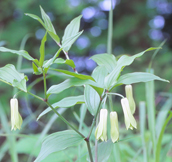
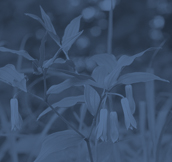 Disporum sessile Liliaceae
Disporum sessile Liliaceae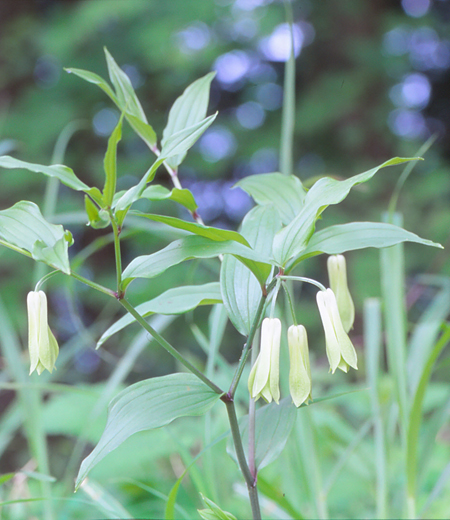 They are perennial plant that grows in deep pool of forests in the mountain areas (perennial plant takes several years to grow). Growing underground stems to increase results in clumps of Disporum sessile. 2 to 3 of flowers bloom dangling downward at the top of branched stem. Their shapes look like a large decoration wind bells (HOU-CHAKU-SO: Disporum sessile) that hang under the overhang of Japanese roof like temples or five-stories pagoda, which is why they are names after. The flower consists of 6 flower petals like a tubular flower, about 2 to 3 cm long, white color tinged with pale green. The leaf is about 5 to 15 cm long and elliptical shape 1.5 to 4 cm wide with the sharp top, and the surface is slightly shiny. After the flowers wither, the seed about 1 cm in diameter bear rounded substances to grow matured into black. Entire flower is tinged with green with the tip in dark violet is ‘Disporum sessile f. melananthum’ which has been discovered for the first time at Mt. Jinba of Inariyama Trail in 1977.
They are perennial plant that grows in deep pool of forests in the mountain areas (perennial plant takes several years to grow). Growing underground stems to increase results in clumps of Disporum sessile. 2 to 3 of flowers bloom dangling downward at the top of branched stem. Their shapes look like a large decoration wind bells (HOU-CHAKU-SO: Disporum sessile) that hang under the overhang of Japanese roof like temples or five-stories pagoda, which is why they are names after. The flower consists of 6 flower petals like a tubular flower, about 2 to 3 cm long, white color tinged with pale green. The leaf is about 5 to 15 cm long and elliptical shape 1.5 to 4 cm wide with the sharp top, and the surface is slightly shiny. After the flowers wither, the seed about 1 cm in diameter bear rounded substances to grow matured into black. Entire flower is tinged with green with the tip in dark violet is ‘Disporum sessile f. melananthum’ which has been discovered for the first time at Mt. Jinba of Inariyama Trail in 1977.
●Season Late April to about Late May
●Height about 30 to 60 cm
●Place Trail 1 to 6, Mt.Inari, Jyataki,Ura-Takao -
Trillium tschonoskii Liliaceae
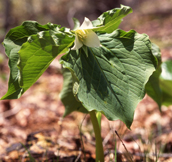
 Trillium tschonoskii Liliaceae
Trillium tschonoskii Liliaceae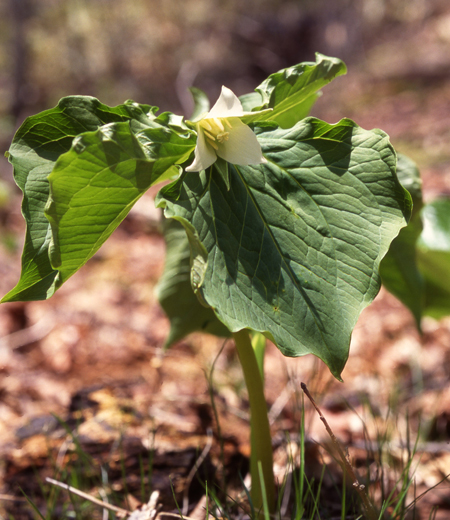 They are perennial plant that grows in the forests of mountain areas (perennial plant takes several years to grow), and in many cases they grow in clusters. The flower is larger than the one of Trillium apetalon by one size, but the entire atmosphere resembles each other much. They are named after that they grow in deep in the mountain areas (Miyama). Also, they have another name ‘Trillium tschonoskii Maxim’ because they bear white blossom. The definite difference between the two is that Trillium tschonoskii Maxim have flower three petals, which are about 2 to 2.5 cm long with the pointed top. Underneath the flower lie three vividly green calyxes. The flower petals of Trillium tschonoskii f. violaceum are pale purplish red. The leaves are extensive egg-shaped with the tip a bit sharp about 10 to 15 cm long/wide, and three leaves develop like embracing at the top part of stalk.
They are perennial plant that grows in the forests of mountain areas (perennial plant takes several years to grow), and in many cases they grow in clusters. The flower is larger than the one of Trillium apetalon by one size, but the entire atmosphere resembles each other much. They are named after that they grow in deep in the mountain areas (Miyama). Also, they have another name ‘Trillium tschonoskii Maxim’ because they bear white blossom. The definite difference between the two is that Trillium tschonoskii Maxim have flower three petals, which are about 2 to 2.5 cm long with the pointed top. Underneath the flower lie three vividly green calyxes. The flower petals of Trillium tschonoskii f. violaceum are pale purplish red. The leaves are extensive egg-shaped with the tip a bit sharp about 10 to 15 cm long/wide, and three leaves develop like embracing at the top part of stalk.
●Season Mid April to about Early May
●Height about 20 to 40 cm
●Place Ura-Takao,Oku-Takao -
Polygonatum lasianthum Liliaceae
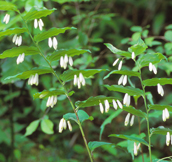
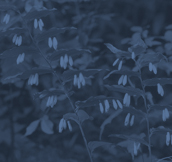 Polygonatum lasianthum Liliaceae
Polygonatum lasianthum Liliaceae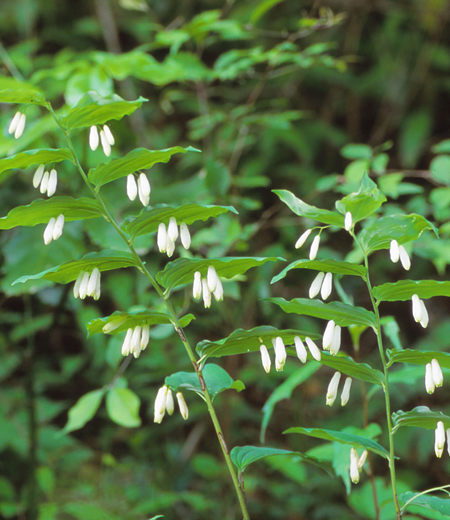 They are perennial plant that grows at forest in mountain district (perennial plant takes several years to grow). Though a part of the name means ‘deep in the mountains’ (Miyama), they inhabit in the forests on the plain ground in a normal way. Though they look like Polygonatum falcatum, the differences to be characterized are the string shaped projection on the stem and wide leaf in diameter. The leaf is about 6 to 11 cm long, elliptically-shaped about 3 to 4.5 cm wide, grows alternate on the stalk. Their characteristic of a leaf is rather hard and its back is white like being flour-coated. The flowers are about 1.7 to 2 cm long white tubular corolla, and the tip of the flower petals are tinged with pale green. They are characterized by the flower filament (Kashi), the stalk of a stamen, where white soft glandular trichome grows in clusters. Peduncles sprout from the root of the leaves and bear 1 to 3 flowers at the top. After flowers wither, they produce the round seeds about 8 to 12 mm in diameter. The seeds get matured to become dark purple color in autumn.
They are perennial plant that grows at forest in mountain district (perennial plant takes several years to grow). Though a part of the name means ‘deep in the mountains’ (Miyama), they inhabit in the forests on the plain ground in a normal way. Though they look like Polygonatum falcatum, the differences to be characterized are the string shaped projection on the stem and wide leaf in diameter. The leaf is about 6 to 11 cm long, elliptically-shaped about 3 to 4.5 cm wide, grows alternate on the stalk. Their characteristic of a leaf is rather hard and its back is white like being flour-coated. The flowers are about 1.7 to 2 cm long white tubular corolla, and the tip of the flower petals are tinged with pale green. They are characterized by the flower filament (Kashi), the stalk of a stamen, where white soft glandular trichome grows in clusters. Peduncles sprout from the root of the leaves and bear 1 to 3 flowers at the top. After flowers wither, they produce the round seeds about 8 to 12 mm in diameter. The seeds get matured to become dark purple color in autumn.
●Season Mid May to about Early June
●Height about 30 to 60 cm
●Place Trail 1, Trail 4, Mt.Inari
